#Elda Furry
Explore tagged Tumblr posts
Text
1 febbraio … ricordiamo …
1 Febbraio … ricordiamo … #semprevivineiricordi #nomidaricordare #personaggiimportanti #perfettamentechic
2024: Carl Weathers, attore, regista e giocatore di football americano statunitense, principalmente noto per aver interpretato Apollo Creed nella saga di Rocky. Weathers si è sposato tre volte. Ha sposato Mary-Ann Castle nel 1973 e hanno avuto due figli. divorziato nel 1983. Nel 1984, Carl ha sposato Rhona Unsell divorziando nel 2006. Weathers ha sposato con Jennifer Peterson nel 2007 divorziando…
#1 febbraio#Adolphus Raymondus Vernon Agopsowicz#Alberto Sorrentino#Aldina Martano#Buster Keaton#Carl Weathers#Carol Dempster#Charles Wyndham Standing#Daniele Formica#Dixie Wanda Hendrix#Dustin Diamond#Elda Furry#Ennio Cerlesi#Franco Mannino#Giuseppina Casini#Hedda Hopper#Hildegard Knef#Isaac Bardavid#John Vernon#Joseph Frank Keaton#Justin Mentell#Katoucha Niane#La principessa fulana#Lauritz Falk#Lisa Seagram#Maria Luisa Mantovani#Marisa Vernati#Maximilian Schell#Morti 1 febbraio#Morti oggi
0 notes
Text

0 notes
Text
Hedda Hopper -- Before the Footlights
Hedda Hopper — Before the Footlights

Today Hedda Hopper (1885-1966) is almost exclusively remembered as a Holy Terror of a right-wing gossip columnist, champion of Joan Crawford, J. Edgar Hoover, and HUAC, and scourge of Charlie Chaplin, Joan Bennett and Ingrid Bergman. Judy Davis played her in Feud, the 2017 series about Crawford and Bette Davis; Tilda Swinton played twin characters strongly inspired by her in the Coen Brothers’ H…
View On WordPress
#actress#Broadway#columnist#Elda Furry#film#films#gossip#gossip column#Hedda Hopper#Hollywood#movie#movies#Republican#star#writer
1 note
·
View note
Text
HEDDA HOPPER
May 2, 1885

Hedda Hopper was born Elda Furry in Hollidaysburg, Pennsylvania. She became one of Hollywood’s most powerful and influential columnists. She appeared on “I Love Lucy” and “The Lucy-Desi Comedy Hour.” Among her hundreds of films as an actress, she did two with Lucille Ball: Bunker Bean (1936) and That’s Right – You’re Wrong (1939). Hopper was best known for her flamboyant hats. She was also a well known conservative, Republican, and staunch supporter of blacklisting suspected communists.

In films and television, Hopper has been portrayed by such actors as (clockwise from top left): Helen Mirren (Trumbo), Tilda Swinton (Hail, Caesar!), Jane Alexander (Malice in Wonderland), Judy Davis (“Feud”), Fiona Shaw (RKO 281), Katherine Helmond (Liz: The Elizabeth Taylor Story), and (not pictured) Holly Kaplan (Netflix’s Hollywood).

Hopper and Ball were friends, although her dedication to her profession often tested that friendship.

Lucy knew it was best to keep the Hollywood press on her side - even against unlikely odds. Hopper, for example, named names during the hunt for communists in the 1950s. Lucille Ball was one of those who were named - although not specifically by Hopper - nearly ending her career.

Talking About Hedda...

In 1952’s “The Gossip” (ILL S1;E24) Lucy calls Ricky and Fred “Hedda and Lolly” after hearing them indulge in gossip about the Tropicana hat check girl. Lolly refers to Hopper’s chief competition, gossip columnist Louella Parsons.

Lucy reads in Hedda Hopper’s column that Rock Hudson is "In Palm Springs” (ILL S4;E26) resting up after a personal appearance tour for his latest film ‘Captain Lightfoot’ (1955).

In “Lucy Becomes a Reporter” (TLS S1;E17) Viv calls Lucy ‘Louella’, a reference to gossip columnist Louella Parsons. Later in the episode, Lucy invokes the name of Parsons’ chief rival, Hedda Hopper.
Hedda On Camera...

Lucille Ball and Hedda Hopper both appeared in the 1936 motion picture Bunker Bean, also starring Owen Davis Jr. and Louise Lattimer.

in 1939, Lucy and Hedda were both in That’s Right - Your’re Wrong starring Kay Kyser. Hedda played herself - something she would do for most of her subsequent screen appearances, despite her roots as an actress.

“The Hedda Hopper Story” (ILL S4;E21) ~ March 14, 1955
Lucy comes up with an elaborate plan to get into Hopper’s column and get some much-needed publicity for Ricky. Little do they know that Lucy’s mother has invited her over for tea.
Ricky:“Mother, darling. Why didn’t you tell us it was Hedda Hooper?” Mrs. McGillicuddy:“You didn’t ask me!”

“Lucy Takes a Cruise To Havana” part of “The Lucy-Desi Comedy Hour” ~ November 6, 1957
Hopper visits the Ricardos in their Westport home to get a story on how they first met. This sets up the flashback to the cruise to Havana. Desi insisted the first installment be 75 minutes instead of an hour. Consequently, in syndication, Hopper’s opening scene was often cut to make the episode fit the time slot.
Little Ricky: “How do you do, Miss Hepper!”

“The Desilu Revue” part of The Westinghouse Desilu Playhouse ~ December 25, 1959
Sixteen of the Desilu Workshop actors join the “I Love Lucy” cast in creating a holiday special. The show aired on Christmas Day 1959 and featured Hedda Hopper as well as many other stars working on the Desilu lot. Hopper arrives at the Playhouse to do a story on the ‘kids’ in the show, and compliments their Christmas tree:
Hedda Hopper:“It would make a stunning hat!”

“Hedda Hopper’s Hollywood” ~ January 10, 1960
Throughout the hour-long special named after her newspaper column, Hopper is never in the same frame with the celebrities. Rather, she introduces 'talking heads’ segments and uses voice-over narration to link them together. Lucille Ball appears on the Desilu lot, talking about the Desilu Playhouse.
Hedda Hopper died on February 1, 1966 at age 80.

#Hedda Hopper#Lucille Ball#I Love Lucy#The Lucy Desi Comedy Hour#Hedda Hopper's Hollywood#Hollywood#The Desilu Revue#That's Right You're Wrong#Bunker Bean#The Lucy Show#Rock Hudson#Hedda#Hats
12 notes
·
View notes
Text
Fake News and Celebrity Culture
*
The Double life of Romney Bay House
Fake news, celebrities, and spaceships are no longer a particularly newsworth phenomenon, they have all been around for a very long time. But Marshians? Well that’s an entirely different matter!
Romney Bay House c1950
Science fiction sells, but bad news sells even better, thus it has earned its keep over the decades from the time that ‘News‘ itself was first coined as a product, by merchants of the C15th. In times of doubt and hesitation ‘new’ and ‘worthy’ information from the north, east, west and south brought in that extra bit of revenue, through facts that were in circulating aiding their affairs. Since then bad news has become more of a weapon to contend with, a mischief that affects more than just economics, politics, and the fear of things invading us from out of space. In recent years “faux facts” have gathered pace, and the internet offers an ever more powerful platform upon which this type of fictional reporting can be circulated, in this regard celebrity culture lends a very powerful hand.
On this basis, and a number of decades ago now, it came to the attention of the older generation of my family that an infuriating little bugbear of a “faux fact” was being circulated in a pamphlet, by a hotel on the east coast in Kent. That hotel had formerly been the holiday home of my great-grandmother Margaret Ethel Bray (nee Barwick 1873 – 1950), one which she had built for herself and her family during the 1920’s. This special seaside family home, once tagged as the ‘Mustard Pot’ owing to its Sandstone yellow colour, is an icon to that era, and it earned its acclaim through the ‘real’ fact that it had been designed by the celebrated British architect; Sir Bertram Clough Williams–Ellis, CBE, MC (28 May 1883 – 9 April 1978), the man who famously built the Italiante style village of Portmeirion in Wales in the very same decade.
The C1920’s was a period of design when Sir Edwin Lutyens (1869 – 1944) and Frank Lloyd-Wright (1867 – 1959) were the leaders in their field, the granddaddies if you like, of C20th architecture. Lutyens had embraced the Arts & Crafts movement in England, whilst Lloyd-Wright became the creator of ‘The Prairie School Movement’ in north America, a celebrated modernist who liked clean lines and organic form. Williams-Ellis was the younger of these men by two decades, but nevertheless he followed their mantra, sharing their beliefs about structures; that these should be created in harmony with humanity, as well as with the environment. The scene of that day would be set with the evolution of the Art Deco movement, it had begun in Paris in 1925, first referred to as the ‘Style Modern’, and it would greatly impact on the period within which Romney Bay House was conceived. Elements of this new style would influence Williams-Ellis, in his more classical design, which would therefore incorporate aspects of modernism, along with that which was termed Vernacular; based in other words on local needs. Today the house is considerably altered from the time of its first construction, but it is still a gem, and will shortly reach its centenary, described by some as a fading beauty, and as a Grande Dame of its day. But it is not my great grandmother who has been credited with its creation, instead a celebrity has been put in her place; the infamous Hollywood gossip columnist Hedda Hopper (1885 – 1966).
In considering the misdeed of this particular “faux fact”, attributing architectural heritage of some relevance from the intermediate years between two wars, to an intruder from Beverley Hills, one can claim to feel much like a jilted lover; suddenly finding that one is party to a bigamist marriage! And although my great-grandmother would not become a celebrated figure like Hedda Hopper, her story is an interesting one, in addition she survived life through two wars as the wife of an army officer, who would then leave her and her children afterwards, but despite this she achieved something with regard to her dignity, and as a single woman, by building a landmark, at a time when money was short and employment was wanting. This show of independence amongst women of that day should be one that earns a certain admiration, a far cry from a poisonous pen! The injustice she is therefore dealt discredits her, to say the least; it is also a libel of fact! But instead of indulging these feelings of rebuke, perhaps one should consider an alternative perspective; take a look at the bright side, and consider the soul of that house instead, viewing things from a different angle. Here we can indulge in its evolution, together with that myth of celebrity for what it is worth, and consider it as further determining the story, for the “Mustard Pot” is uniquely situated within a small corner of England, and one that for some has come to be known as The Fifth Continent. It is in an area of land with its own particular coastline, one which became notorious at the turn of the C19th, both as an ideal spot for bathing and for landing a spacecraft; an unusual kind of sphere, having returned after taking the first men to the moon, and yes, in this you would be correct in assuming there is a great deal more fiction than fact.
As far as Hopper is concerned she herself is not a fictitious character. She was indeed an author of sorts (all be it one with a ghost writer – who was renowned for being unable to spell) ‘infamous’ for being a wrecker of more than one Hollywood career and marriage, through the engrossing power of her unscrupulous pen; a weapon that spoke not of legends in the true sense of the word, but of clandestine affairs’ amongst C20th screen idols, goddesses and celebrities. The lovers Ingrid Bergman and Roberto Rossellini were her most notable conquests. The actor Bob Hope once described Hopper’s column as “the first thing we looked at every morning in order to see what was going on,” but Joseph Cotton on the other hand, who famously featured in Orson Wells film ‘Citizen Kane’ was known to be far more resentful. At a star studded dinner in a Beverley Hills Hotel, Cotton walked up to Hopper as she was about to sit down, and pulled the chair right out from underneath her, his words were: “I’ll kick your ass, if you ever write anything about me again!” The ‘Femme Fatale’ Joan Bennett was also known for having feelings of wrath towards Hopper, she famously sent her a skunk on Valentines Day. Hopper was a ‘bitch’ with style! But despite all this it would seem however that she did have a fan in Kent, and such was the case that with many years passing from the time of that first pamphlet being circulated, the myth about her building a holiday home in Kent had eventually morphed into hard fact. It was as if Hedda Hopper had mysteriously arisen from the grave, and with all her “pen” venom and allure, had once again spread gossip that would be the cause of offence; a PR stunt perhaps, designed with motives of promotion, in a period where negative publicity has become the new positive.
***
The Fifth Continent wherein The Mustard Pot exists for real is a land in which dreams and fairy tales are made, and indeed they were made up by an eccentric C19th Reverend from Kent. He was perhaps more literary genius than the imaginary builder of Romney Bay House, even though his stories had also been serialised like hers in the column of a magazine. Here was a man called Richard Harris Barham (1788 – 1845), an English humourist and member of the clergy, who had evidently found that he had far too much time on his hands, so rather than dealing with tittle-tattle like Hopper, Barham used his considerable talent at storytelling instead. In this respect he was better known by his pen name of ‘Thomas Ingoldsby of Tappington Manor’, and so armed with his Nom-de-plum he set about writing a series of grotesque ‘metrical’ tales that became known as the Ingoldsby Legends; a popular collection of myths and ghost stories that included poetry, and which the most famous of all was ‘The Leech of Folkestone’. In this tale we discover that “The World, according to the best geographers, is divided into Europe, Asia, Africa, America, and Romney Marsh.” Hence the reason that Romney Bay House is known to be situated in a unique corner of England, within a continent all of its own, and of course one in which the people who live there must obviously be known as Marsh-ions.
“The World, according to the best geographers, is divided into Europe, Asia, Africa, America, and Romney Marsh. In this, and fifth, quarter of the globe, a Witch may still be occasionally discovered in favourable, i. e. stormy, seasons, weathering Dungeness Point in an eggshell, or careering on her broomstick over Dymchurch wall. A cow may yet be sometimes seen galloping like mad, with tail erect, and an old pair of breeches on her horns, an unerring guide to the door of the crone whose magic arts have drained her udder. I do not, however, remember to have heard that any Conjurer has of late been detected in the district………”
extract from Mrs. Botherby’s Story – The Leech of Folkestone.
Up until Ingoldsby had upgraded Romney Marsh into something of an agrandized and legendary land, one wherein a witch might occasionally be found, that marshland had been one of no particular interest to anyone, other than of course the wild things that grew there and the sheep that grazed upon it. Strangely, and maybe by no coincidence, those sheep were not ordinary beings, and as such they became one of the most successful and important breeds in the world, yes I mean literally in the whole wide world! Mostly this was because of their ability to feed in wet marshy situations, and survive the inevitable foot rot that would ordinarily be the detriment of other breeds, as well as the internal parasites too. As a consequence of this curious immunity, in the C19th the land would become dominated by a sheep stock greater in density than anywhere else on the planet, or within any continent either. These miraculous sheep would therefore be selectively hand-picked and then shipped overseas wordwide, to other destinations of wet and marshy land, in order to strengthen the native breeds.
Conflict……
Exposed as it was that recondite land of dreams and reverie was also one that was vulnerable, owing mostly to it position on a limb that juts out awkwardly at the ankle of England. It was at one time a bit too close to the ‘Holy Roman Empire’ for comfort, and more importantly to that bit called the ‘French First Republic’! Several Martello towers would be erected for its protection during the Napoleonic era, a time when the British government lead by a young William Pitt would consider opening the Romney Marsh sluice gates, to deliberately flood the land; a means of “defence strategy”, the intention being to discouraging troops from landing there, and using it as a bridgehead. In substitute one of Kent’s most fascinating landmarks would be established instead; the Royal Military Canal that would run between Folkestone and Rye, a hand dug device driven by the fear that Napolean would eventually succeed in his desire to plant the Imperial Eagle on the Tower of London. Curiously that two headed Eagle had managed to sneak its way upon a Coat of Arms belonging to the family of Margaret Bray’s husband, perhaps an uncomfortable truth lurked there? But of course Napolean never did come near to conquering Britain, and when the canal was eventually finished in 1809 it ended up as a costly embarassment, meanwhile the marshland continued unabated as if everything was perfectly normal; nature had cloaked it with powers of its own.
In 1804 it had been John Rennie (1761 – 1821) that renowned engineer of bridges, docks and canals that would be appointed as consultant to the military canal project, he would be abruptly dismissed a year later, after only a six miles section of the main channel had been dug. It was the hard winter with frost, flooding and shortage of labour that would be blamed. So when the canal was eventually finished five years later, the threat of invastion had already passed, as Napolean had needed to set his sights elsewhere in Europe, he would never come to rule Britain or her waves, or even come near to Romney Marsh, its spirit was inconspicuous but discreet in averting. During the First World War the same idea of flooding that marshland would once again be considered, this time in defence against the Germans, but it never took place, then again in the Second World War too when that coastline would become useful in 1944 for launching the D-Day landings. But the marshland would continue as undaunted as always, cloaked in her protective veil, and her wildlife would escape the turmoil as if all was just a big to-do! At that time a portable temporary construction, known as a Mulberry Harbour would be launched from the other side of the channel, a military device designed by the British to sink or float, for quickly off-loading cargo during action. A section of it is still visible on a good day at low tide from Romney Bay, a relic of the past. But before either of these later military conflicts would add their affray to its history, that area of coastline which offers miles of unadulterated sandy beach at low tide, had come to be the ideal spot for the author H. G. Wells to land a spacecraft in his novel The First Men in the Moon (1901). As second in line to Gothic novelist Mary Shelley (who invented Frankenstein), Wells is the celebrated grandaddy of the Science Fiction literary genre; the pioneer of extraterrestial life, and although his spacecraft is now a very real and plausible vehicle, back in those days long past, the Wright Brother were only just testing their first bi-plane prototypes.
So after this feast of beguiling but bygone years with its triumphs and tribulations of war, let us fast forward to the present day. Let us now turn our attention to the C21st, and to Hedda Hopper’s association with Kent. Curiosity surrounds that ‘fantasy fact’ that she had built and then lived at Romney Bay House, to the extent that this had now escalated into print (The Rough Guide to Kent, Sussex and Surrey by Samantha Cook and Claire Saunders – “presiding alone over the lonesome shingle like a fading Grande Dame”), in fact it has been variously written up, as well as being included in local guide-books and the like, even a photography courses offers the opportunity to ‘photograph’ where the star once lived. The association of the house with the celebrity gossip columnist had even become a ‘factual’ source on Wikipedia too, as well as heaven forbid within the RIBA image library itself, where her name had come to grace data on the house at the heartbeat of British architecture! So let us now consider the truth of this ‘Hopper’ in greater depth, exactly who was this celebrity ‘Hollywood Gal’, and why should she be chosen to doppelgang my formidable and trendsetting Great Grandmother?
***
Hedda versus Margaret….
Mystery Train (1931)
Hedda Hopper first rose to fame as an American screen goddess in the early decades of the C20th. She was born and raised in the town of Hollydaysburg in Pennsylvania, baptized as Elda Furry, and of parents who had been strict members of the German Baptist Brethren. The Furry family were certainly in the right place as far as non-conformism and Pennsylvania was concerned, this was a protestant dissenter state founded by William Penn, one of England’s foremost and earliest Quaker’s, a renegade of the Orthodox Church of England. Penn had wanted to create a safe haven for his fellow worshippers; refugees that needed to escape from persecution in his home town of Bristol at the end of the C17th. It was a period after the Commonwealth had collapsed, when the Monarchy of England had just been restored, money was short and Charles II owed a large debt to the Penn family; a bargaining tool therefore to put things in place. But lets not get too carried away with all this, as the Furry family had originally been of Dutch-German descent.
Young Elda’s acting career began after she had become tired of being tucked away in a north American backwater, in the puritanical home of her religious parents, in which there were eight other children to think of. She had studied singing during her high school years, and had developed dreams of pursuing a career in musical theater, but her parents were firmly against it, thus she made plans to abscond, running away to the bright lights and the big city of New York. On arrival she found work on Broadway in the chorus of an opera company. Once she had establishing a job within theater, and being ambitious as she was, she was then able to up her game. In 1908 she managed to get a part in a musical comedy called “The Pied Piper,” where she joined the company of an actor called William D’Wolf Hopper, and they would performed together again in “A Matinee Idol” in 1911. Hedda had met the man she would later marry.
William Hopper (1858 – 1935) was a well established American actor, singer, comedian, and theatrical producer, referred to as Willie at the start of his career. He then became known as Will, and then finally as Wolfie! But on a professional level he always preferred to be known by his more scarey name of DeWolf. So Elda would marry her husband Wolfie in 1913, thereby taking on the Hopper surname, but all was not yet complete. Wolfie had already been through four previous wives by the time she had met him, all with similar Christian names to Elda; Ella, Ida, Edna and Nella, and this meant that with slightest slip of the tongue Wolfie would have her mistaken for one of her predecessors. So, it would be on this stumbling block that a plan would be hatched to change her name even further, so after employing a numerologist ‘Hedda’ would be conceived, as a means to avoid further insult and injury. From that time forward the actress Hedda Hopper came into being for real, and the Quaker born Elda Furry would vanish for ever.
***
And so to Margaret…
Portrait of Margaret Ethel Bray (nee Barwick) in her debutant attire at the time of her ‘Presentation to the Queen’ in 1894
Margaret Barwick as a child (left), with her sister Edith (centre) and brother John on the Durham heritage coast
Margaret was born in the month of June 1873 in the city of Sunderland, Durham as Margaret Ethel Barwick, and she was by contrast to Hedda Hopper her almost exact opposite, in everything other than their apparent love of extravagant and ornate hats!
Having been raised in the Tyne & Wear of northern England on the opposite side of the Atlantic, Margaret would not only come from a different country, but by being some twelve year’s older than her American counterpart, she would also belong to an entirely different generation. So these two women not only came from lands poles apart, but alternative walks of life, and vintages too. As far as Margaret was concerned C19th women from her background were subjects of an elitest society, one driven by empire, and then by war in Europe. It was an age of paternalism and patronage, with the expectation that a woman’s roll was to be that of a wife and mother, devoted to family duty and housekeeping; to be seen as the angel in the home, and only a few women would escape this ordeal. Prior to the Victorian era women had enjoyed a little more by way of rights, but with the passing of the Reform Act in 1832 specifyied that ‘male persons’ only would be able to vote, ‘outrage’ would become their goal to pursue. Men controlled the land, even that belonging to their wives, and all of finance too, very few women would therefore be able to make it into the intelluctual world, and those few would have a pretty rough ride. The Suffrage Movement would begin in 1848 as a consequence, and so by the time Margaret herself had reached her coming of age, almost half a century later in 1894, things would still be relatively unchanged; only a Local Government Act had been passed allowing single woman rate payers to vote in local elections. This system of society and governance would continue on for many years to come.
Margaret’s parents were not staunch Christians like the Furries, and they were by no means high-church followers either, they certainly weren’t Quakers or for that matter any other form of dissenter, they were just ‘gentiley’ religious in what was considered apropriate in England for that day. As for running away with a desire to make a living in theatre, there would be no need for Margaret to do that, although she did have a sense about her rights. In truth her parents would be able afford for her to have most things that she wanted, and that would include a position in high society, and in her day this would help to alleviating to some extent the injustice toward her sex. Had she wished to work then most likely she would have been prevented, and without womens rights in the workplace who would want to anyway. However, Margaret and her siblings did by all accounts enjoy playing at theatre, dressing up in fancy dress costume, and participating in various roll playing accordingly.
Margaret Barwick in theatre costume c1885
Margaret (centre) playing cards with her siblings at Ashbrooke Grange
By contrasting Hedda Hopper’s chorus line debut on Broadway, Margaret’s would be a more sober affair, that of being a “debutant” at her coming of age. She would then have had the pleasure of being ‘presented’ to an elderly Queen Victoria, and this would be a premier performance of sorts. It would set the stage for her upon entering into society as a young lady, but more importantly it would be a means of courting the marriage market. Margaret’s father was an ambitious man, and both her parents would have been keen to make a good alliance for her, one with similar folk of an industrious nature, benefitting their daughter as well as the family overall. I dare say that the novelty of Hedda’s adventures might well have seemed exciting to the young Sunderland heiress in her earlier years, had she been the younger of the two and not from an earlier decade, inspired by day dreams of all that might entice her on the other side of the world. However, the reality for Margaret would be a fate somewhat different to that of her so called imposter, especially by the time she would come to build and own a seaside home for holidaying in Kent. That would be many years after her coming of age, but it would be just two years before that the Conservative goverment in Britain would make a start at unfastening the female straight jacked. In 1928 when Margaret had reach 55 years the Representation Of The People Act would be passed, and this would mean that the vote had at last been given to all women over the age of twenty-one, and on equal terms with men, but it had taken two lengthy wars in which many lay dead, including her two step-sons. Nevertheless the age of female recognition had arrived at last, and alongside the inauguration of her Romney Bay seaside house.
***
Durham in the C19th…..
The Kingdom of Heaven is like a mustard seed planted in a field. It is the smallest of all seeds, but it becomes the largest of garden plants; it grows into a tree, and birds come and make nests in its branches.
Despite the chilling politics of the day, and the damp cold north-eastern climate of England, the Barwick family home where Margaret grew up would at least have been one that was warm, although it would have been a far cry from the hot hummid summers on the east coast of America, with its lush golden autumn colours, and deep swathes of white winter snowfall. At that period of British history freshly mined coal would have been more than abundant in Sunderland, ready for filling the hearths and fireplaces of the large family home at Ashbrooke Grange in the city, as well as their country estate of Thimbleton Hall, set high on the North Yorkshire moors. Margaret’s father had been a man of shrewd and considerable talent; Sir John Storey Barwick (1840 – 1915) was not just a skilled entrepreneur of industry in the C19th, he was widely regarded in his day as one of the commercial magnates of the north.
Sir John Storey Barwick
Great things come from humble beginnings, and the sewing of a mustard seed can thus be seen to be the subject of both an allegory and synonym, because it is one of the tiniest seeds, from which can grow an immense tree. As such it has been symbolic within mythical tales and philosophy; the Egyptian King Tut had these seeds thrown into his sarcophagus after his death; whilst German brides have traditionally had them sewn into their wedding dresses. Where this story is concerned, the mustard seed can be seen to be the kernel from which Margaret’s house ‘The Mustard Pot’ would sprout, as that seed would be sewn through her father John’s determination then prosperity, both of which he would pass on to her.
John spent much of his early life in Sunderland, he grew up in the area of Bishopswearmouth and was educated in the city. He was the son of a local farmer and landowner, so he came from an agrarian lifestyle, a more humbler beginning to that of his off-spring. Then through hard work and ingenuity he made his way up the ladder of industry, eventually to becoming the owner of his own coal-mine and quarry, at a time when the value of that commodity meant it was considered to be more a form of raw diamond than black rock! The various coal mines he had a hand in would supply industry at a point in time when Britain was an imperialist power; an Empire that ruled the world, and that empire had ships that sailed into every port of the globe using coal as their driving force. At the turn of the century Britain was still on the rise toward its pinnacle, an economic climate wherein transportation would be seen as the crucial element and Barwick had a finger in every pie, including an interest in shipping, it would mean that he would be eligible for the hand in marriage to the daughter of a Tyne & Wear shipbuilder, a man called George Short (1815 – 1863), founder of a company that built liners for cargo such as coal, and later for passengers.
For the climb to the top John Storey Barwick began as a fitter within the Ryhope Coal Company. Having then established his worth, he would work his way up further, through the various layers of management, demonstrating a keen business acumen and style. This would allow him to go on and become a director within the North Eastern Banking Co.; The Northumberland Steam Shipping Company; The Weardale Steel, Coal and Coke Company; The Cargo Fleet Iron works; The Wingate Coal Company and even more futuristically within the European Petroleum Company. Eventually he would become one of the largest shareholder in the British transport Company of Furness Withy & Company, founded in 1891 with eighteen ships operating between New York and Newcastle. The question that begs asking is, how on earth did he find time to squeeze all of this into an already busy work schedule? But that would not be all! It was as a result of his keen sense of business and ingenuity that he would then be invited to become a member on the board of the North East Railway Company, a useful position to be in for the transportation of coal. And so on this basis and in 1899 John Barwick together with his business partner Christopher Furness, 1st Baron Furness, would jointly found the Easington Coal Company; a private enterprise at the onset, that would go on to develop a virgin coalfield on the east coast between Hartlepool and Seaham. In more recent times that mine has become famed under the pseudonym of “Everington” screened as a musical and theatrical productions of Billy Elliot (2000). Hedda would surely have approved! The North East Railway would play a critical roll in that mine, and when the first pits of Easington were sunk in 1899, thousands of workers would come to live in the area. They came from all parts of Britain, bringing new life and a new community with them that would endure for a century to come. Shops would spring up, along with pubs, clubs and cinemas, amongst row after row of terraced housing. All of this had been motivated with Furness and Barwick acting at the helm.
The heyday for the Durham Collieries would be in 1913, a ten years gap after the first sods of the Easington Colliery had been cut for the quarry. By the time of its peak there would be 304 pits in the overall area, as well as 166,000 miners all with jobs, and producing 41,400,000 tons of coal. The first of Easington’s black combustible diamond like rock would not be drawn until the year 1910, when coal of a high grade would finally be able to be excavated. Then in 1912 the first coal would be shipped from Seaham, and the railway station would open its doors to passengers for business. It was a point at which new shareholders would become necessary to further increase the companies overall capital; perfect timing by Barwick and Furness in terms of the Easington timetable. It was this ripe judgement that would encourage those with the means to invest to get involved by parting with their cash, and putting it into a sound investment. Of course the mine would become nationalised much later on after the second world war in 1947, its founders long dead underground. Then in 1951 disaster would strike, and 83 miners would lose their lives. Much later on in 1984 the miners strike would hit the colliery, lasting for all of a year, and then finally the last coal would be drawn in 1993. A century had past, a hundred years of enterprise, of engineering and of hard labour. Coal had had its day, and oil would take its place.
Pit Cage Monument of Easington Colliery; a relic of days gone by
Long before Easington had been conceived, the north eastern alliance between the Barwick and Short families would bring into being a new generation of children. Their brood would consist of four girls and two boys, of whom Margaret would be the eldest, and they would be fortunate enough in their early lives to be raised mostly in the lap of luxury, wanting for nothing….. except perhaps their freedom! And so from this platform, and as her adult years hailed into view, a parallel can now be drawn between the lives of Margaret Barwick and Elda Furry. By the year 1895 and having reaching the age of twenty-two, Margaret had begun to tire of living at her family home, and so she looked around for a form of escape. Home life had developed a climate that was perhaps a little too dedicated to her two younger brothers, and those two young lives dominated the family scene, as they would eventually inherit the show. But thrown into this were also the needs of three younger sisters, and their mother was by then beginning to slowly deteriorate through a heart condition. Like other young women of her age, Margaret was keen to begin her own adventure, and the idea of taking flight began to take precedence over all her other thoughts; surely there must be a another world out there beyond family territory? In the event she was ‘saved,’ or at least so she thought, by the arrival into her life of a dashing army officer, and one who was commissioned in the Royal Berkshire Regiment that were stationed near to her home in Sunderland.
Reginald Edward Traherne Bray
Margaret was spellbound! Was it the military pomp, or perhaps just a man in uniform, and one who had come from a staunch military family, well-known for their valour. Reginald Edward Traherne Bray was undeniably handsome, fair haired with fine features, and he was the son of a Major-General who had been in command of the same regiment. Reginald was like Margaret the eldest of a large family of three sister, and four brothers who were all in military service too, but he was some thirteen years older than his would be bride, and had already lost one wife, who had recently passed away in childbirth, leaving him alone as a widower with two young infants under the age of three. But as far as Margaret was concerned life with Reginald presented a welcome challenge, an adventure with travel, and an altogether new beginning away from sibling rivalry. Little did she know what the future would bring hold, and so she now entered into this new world, as the angel in the home. As such she not only became a wife but a step-mother too and within the confines of army life, where conditions would have been somewhat different to those she had grown used to. Two years later in 1897 her first child Peggy would be born, and then with the arrival of two further children; Winifred and John, three and six years younger, by the time of 1903 Margaret had completed her family.
……A few thousand miles away on the other side of the North Atlantic Elda Furry would be making plans of her own, also to abscond to freedom! Her mission was to seek out the opposite end of the spectrum to that of a military lifestyle; establishing her independence in her first theatrical roll in the city of New York.
Margaret Bray with her first child Peggy in 1897
Oh for the love of fun, but perhaps not the trouble that it gets one into! Clearly Reginald loved soldiering, and perhaps more than he did his wife, as well as everything else to do with the military. Coupled with a perhaps somewhat shy disposition, he was not geared up for the kind of serious socialising that Margaret would probably have liked to participate in. Disagreements would begin to take shape between these two opposite characters quite early on in their marriage, and of course he most probably missed the love of his first wife. Was he a cad and a bounder? Or perhaps just someone who fell into a tub of butter, and then couldn’t bear to get out. Either way Margaret was of course quite the lady; stalwart and headstrong, determined like her father and a force to contend with. She had a good intellect with a mind of her own, and was not about to give up the fight! So life continued a pace with military precision, and a posting to Fort William in South Africa took the couple overseas after the birth of their first daughter, where upholding of the British Empire mattered more than just marriage. But gradually the strict rigours of regimental life, and her husband disposition would begin to take its toll, within a society geared toward male power. With war on the horizon the couple would finally separate, arguments had surrounded the use of Margaret’s money, and Reginald’s sons who would leave England for a new life in Canada, would return shortly after in order to enlist. It would be Reginald who would end up paying the heaviest price.
And So to War….
Aubrey (left) and George Bray Soldiers who died in the Great War abt. 1915
The First World War began in Europe in 1914, and it would be that which would take centre stage in the hearts and minds of an anxious British public, with America taking a neutral position until the year 1917. As far as England was concerned a generation of young men would be annihilated, and so for this country there would be hell to pay. Amongst all this would be Margaret’s two step-sons; George and Aubrey Bray, both on the cusp of their adult lives and aged just 21 and 22, the latter losing his life first in 1916 at the Dorjan front of Greece. George Bray had been a Lieutenant in the same Royal Berkshire regiment as his father, where British troops were part of a multi-national Allied force fighting in the Balkans. At the beginning of August 1916 three French and one British division launched an offensive against the Bulgarian position, attacking on the 9th August with heavy artillery fire, the battle would continue with a series of attacks until the 18th August, when they were eventually forced to retreat with heavy casulaties. George would be one, who would die from his wounds. He is buried at the war cemetry in Kasouli.
………Over on the other side of the Atlantic Hedda Hopper would be busy elevating her professional life, she had moved into silent movies, joining Samuel Goldwyn’s film company in Fort Lee, New Jersey. Her first roll was performing in The Battle of Hearts in 1916, a very different kind of battle from the one George had died in. This would be followed by four more titles the following year. Hedda may have found a degree of success, but she had not yet fallen into that vat of butter, and conditions within the dressing rooms and offices of Goldwyn were said to be poor, being within an abandoned barn with no ceiling, and on top of this the work was said to be long hours and sometimes very trying. But Hedda, like Margaret, was a very determined lady.
Back in Europe George’s younger brother Aubrey would follow him into the grave, dying of his wounds in the Battle of the Somme in 1918. Aubrey would receive the ‘Military Cross’ for his bravery post-humorously, a hero from a different kind of ‘theater’ to that of Broadway. Things would never be the same again in Britain, or for Margaret and her inconsolable husband Reginald, whose own war had finished early due to illness. He now sought solace in the arms of a young and devoted housekeeper, one with lower aspirations to that of his wealthy wife. Reginald’s three other children would barely ever set eyes on their father again, and he would retreat into the Devon countryside, while their mother would make a home in London, eventually setting her sights on Kent.
When war in Europe came to a close in 1918, the population of Europe had been considerably lessened, particularly as far as the male sex was concerned. The chance for a woman to obtain a husband had been somewhat reduced. Many would remain spinsters for the rest of their lives. But the positive was that the elitest society that had been so partial toward paternalism would now begin to lose out in terms of its corporeality, and things would have to change. This would mean that women would be allowed to have more by way of rights. Reginald’s young housekeeper would surely have been one of those female casualties, seeking out the opportunity to snap up some male support in the face of all the carnage, and by all accounts Reginald’s lover would also be younger still than his already much younger wife.
…….By the time the 1920’s arrived Hedda would once again be elevating her prospects, by moving to Hollywood with husband Wolfie, and commanding a much more handsome salary; she was becoming known as ‘Queen of the Quickies’ featuring in support roles as a vamp. By 1922 she had performed in more than a dozen movies, but like her British counterpart, Hedda’s marriage was also arriving at a full stop! She now wanted a divorced from Wolfie, which was granted her in 1923, a couple of years before the plans for Romney Bay House would be draughted out.
In war ravaged Britain there would be no divorce on the cards for Margaret, with a rumour passing down through the family that the British law courts would not grant her such, unless she could prove desertion. This was something her husband was unwilling to oblige her with. So without her freedom Margaret would be unable to remarry, and she would have to go it alone for the remainder of her life, which was something she did with style, grace and decorum. Instead she would become resolute in establishing the adult lives of her children, all of whom would become successful citizens, marrying and raising families of their own. As a consequence of that dedication, in 1923, and at the time of Hedda’s divorce, Margaret’s son John would graduate from Cambridge University, with a BA Honours. He would then go on to study medicine at St. Bartholomew’s Hospital, qualifying as a medic 1929, and becoming a bacteriologist. During the Second World War Dr. John Storey Barwick Bray (1903 – 1985) would be responsible for isolating the ecoli bacteria for Gastroenteritus in children, which then had a high mortality rate. It was a landmark victory both in its diagnosis and control,’thus all who care for infants owe John Bray a special debt of gratitude for this discovery’.
Margaret Bray with her three children abt. 1910
…..Meanwhile on the other side of the Atlantic Hedda would be upping her game further by becoming a player for Mayer Pictures, later known as Metro Goldwyn Mayer (or MGM as we know it today). By 1924 she had managed to obtain custody of her only son with Wolfie (he woulld become the television investigator known as Perry Mason), and so for the remainder of the 1920’s she would be a pretty busy lady keeping things together, and keeping her show on the road. Whether or not she ever set foot at Romney Bay in Kent during this period would seem somewhat unlikely; and history doesn’t relate. Up until the 1930’s she had appeared in more than 50 movies, a time when her career as a screen goddess would finally begin to wane. This was the point at which she would look around for another source of income. Maybe a little time over in the Fifth Continent would have been just the very thing? Whatever the case, it would be in 1935 that Hedda would agree to write for the Washington Herald as their gossip columnist, later she would move over to the Los Angeles Times. So from that time onward her notoriety as the ‘Queen of gossip’ would take precedence as far as her image would be concerned, and she would thrive in her new roll as that bitch from Beverley Hills. Hedda did continue to act and she played in dozens of other films right up until the year of her death in 1966, but it would be in her roll as gossip columnist with 35 million readers that she is best remembered, particularly as regards her alleged house in Kent.
***
Appearances can be deceptive….
By the time I the writer became caught up in this saga of a celebrity fairy tale attached to my great-grandmother’s Romney Bay House, my mother and uncle had already been hard on the case! They were eager to put things to right. This was not just for the sake of family heritage, but also in virtue of their grandmother with whom they had shared memories, but it would be to no avail. On becoming a hotel planning permission had been granted to alter the facade of the house, and in addition its history had evidently been altered too. Photographs of “The Mustard Pot” that had been taken over the years littered our family photograph albums, but in this respect its soul had been hijacked for PR purposes, or so it would seem. The original Classic/Deco-esque facade is now barely recognizable, with its original windows removed and replaced with alternatives, and it has lost something of that distinguished seaside holiday appearance, styled with such care by Clough Williams Ellis. Today extensions adorn either side of the building, somehow belittling it and cheapening its image, the front porch and balcony behind its columns have been filled in with glass, likening it to an office block. Instead of that traditional sunny sandstone colour, which gave the house its nickname The Mustard Pot, stark bright white stares out blindingly from in front of the marshland. But despite all these alteration, when a picture appeared alongside a written review by the journalist and writer A. A. Gill in his column in the The Sunday Times, I could not be duped. This was a relic of our family heritage, and not an American outpost.
Adrian A. Gill (1954 – 2016) was once a well-known critic and restaurant reviewer, who for a time was married to the MP The Right Hon. Amber Rudd, until Amber came home one day and found him with another woman, and in bed! Some celebrity tittle-tattle Hedda would no doubt have loved to have revealed in her newspaper column. Gill had won numerous awards for his writing talent, factual or not, and his very first piece having been published in Tatler magazine, another celebrity area that Hopper would have been delighted to peruse, had she lived within these shores. Notorious and erudite as Gill always was, there was nevertheless an abundance of complaints leveled against this critic to the Press Complaints Commission, and my letter of indignation regarding the truth would have no doubt been small fry by comparison; I anyway never heard back, it was just too unimportant. That was many of years ago now in 1998, and Gill has since sadly passed away, but the myth has continued to garner in strength. Although as I recall he did give rather a good write-up for the then owners of that Hotel business, trading of course on Hopper’s name; a ‘Chinese whisper’ that I doubt Hedda would have sanctioned, as she was at least credited for writing the truth! And when the truth was out, she knew she had made the ultimate score. So arriving finally at the point we reach the mark of honour endowed upon the house, which comes through its real creator, that being the architect Clough William Ellis. What would he have made of the alterations to his design, the artwork and intended style that he would want attached to his name.
and so to the creator…..
Sir Clough Williams Ellis – NPG collection
Clough Williams Ellis had no personal known links to Kent. He had been born in Northamptonshire, but like the American architect Frank Lloyd Wright, he considered himself a Welshman, inside and out. Wales had been the land of his forefathers, and his own family had returned to live there when he was still just a small child. After leaving school Ellis had briefly attended Cambridge University, although he would never complete his degree, instead he decided to attend Architectural school, and this would begin the career that would make him into one of Britain’s more notable architects of the C20th.
By the year 1925 Williams Ellis had reached the mature, but still relatively young age of 42! He was just completing his Portmeirion project in Wales, designed to encourage tourism in Wales, and described recently in the Telegraph newpaper as “the oddest holiday village on Earth; a dreamlike place, which in spite of its small size, is somehow capable of displacing reality.” It seems Williams Ellis was unquestionable the right man for the job in terms of building within the Fifth Continent! At the time he had already come to be regarded as one of the ‘Uncles’ of architecture, a way of observing that he had perhaps not quite yet reached the status of the Grandaddies: Lutyens and Lloyd-Wright, but he had earned respect, and was influential enough to bring about a forward thinking rebellion amongst young and aspiring structural draughtsmen of that day; encouraging them to broaden their influence in terms of style. His view was that these new kids on the block should ‘cherish the past, adorn the present, and construct for the future’, something he would aim to embrace, whilst remaining true to the neoclassical ideal. On this basis and in 1926 Romney Bay House would be completed, with its final coat of render being applied to the exterior in preparation for that yellow sandstone paint. At the time Britain was in an economic depression, it was a time of deflation when money was short and unemployment high.
Margaret’s three children: John (left) Peggy (centre) and Winifred abt. 1924
The Roaring Twenties – Winifred’s husband Alistair MacLeod in his Talbot car
A sense of emotional numbness still lingered around coming to terms with war; one that had finished less than a decade earlier. This was a juncture when many of Britain’s stately mansions would become abandoned, either falling apart through lack of funds, their owners crippled by death duties, or with their heirs wiped out altogether; casualties of the trenches that would never return to claim back their prize. But all of this would have little impact on evolving architecture. Instead the lack of finance would bring into effect the use of steel frames, and concrete blocks, replacing traditional methods of building, with new materials. Trends were changing, and in 1925 in Paris the International Exhibition of Modern Decorative and Industrial Arts would set a new standard introducing the Style Moderne, which would spread to America and England as the Art Deco movement, also bringing in its wake what would become called the ‘International Modern Movement’, defined later but from that same era. This influence would be taken up by Williams Ellis, and aspects of the style would influence the classical lines that Romney Bay House would be built along, giving it square pillars instead of round, and an altogether more minimalist interior, the embracing of simplicity, reflecting the landscape that at first appearance gave a sense of bleakness.
During those inter war years; within the eye of the storm, the tabloid press would be tagging a group of young upper-class rebels, they would famously kick start into action the modern cult of celebrity, which of course this story has its links to. These attention seeking and flamboyant youths were mostly the off-spring of aristocrats who had been too young to fight, and they would famously become known as “The Bright Young Things”, chased after by the paparzzi for their outrageous behavior. Partying and treasure hunting around the countryside in fast cars would be their thing, and amongst these would be the later Poet Laureate (from 1972) a man called John Betjamin (1906 – 1984). He would become a close associate of Clough Williams Ellis, once he had found his role as assistant editor of Architectural Review between the years 1930 – 1935. It was a time when Hedda Hopper was just beginning to make her mark through her gossip colum on the other side of the Atlantic. Betjeman and Williams-Ellis would both become keen supporters of the Style Moderne, with views that it might bring a breath of fresh air into the post war depressed architectural scene, a counterblast to the impact of war and conventional taste. But neither of these men would be prepared for the bad taste that would follow, in terms of “urban sprawl” which was just beginning to creep parasitically across England from the mid ’20’s. As a consequence of this, Williams-Ellis would become the leader of a resistance movement, and he would become dedicated to this, with Betjamin as his closest ally. Much later they would be supported by the British architectural critic Ian Nairn (1930 – 1983), who would become the country’s first popular ‘architectural journalist’ in the ’50’s, following his special issue of Architectural Review dedicated to “Outrage” (1955), through which the term ‘Subtopia’ would become coined. It was all of this that had been the real impact that the numbness of war had brought about, an inability to observe sensitively, coupled with the ugliness of how a nation felt. Whatever the case Betjamin would later write hiss well known poem “Come Friendly bombs and fall on Slough, it isn’t fit for humans now”, an epic for every child during the ’60’s and ’70’s. Ian Nairn’s “Outrage” and Betjaman’s poem would however be written some years after Clough Williams Ellis had completed Romney Bay House, as back in those days when the render to its walls was being applied, Betjamin was still studying at Magdalen College, Oxford, being tagged as a rebel! Like Williams-Ellis he too would leave without his degree.
First architectural plan for the house and garage.
In its concept Romney Bay House would come into being through a simple idea that had been dreamed up a year or so before its plans were put on paper. Margaret’s youngest child John had just entered medical school, having been one ‘bright young thing’ that did complete his university degree. Her two daughters Peggy, and Winifred, had both essentially left home. Peggy had become married with a small son, and Winifred would be too before long. A weekend and holiday retreat in a sociable location was thought to be just the thing for her to escape the hum drum of city life, and it would offer a means whereby of entertaining her grandchildren later on, as well as allowing her to enjoy the hot summer months by the seaside with her family, breathing fresher sea air than that of the city. On this basis Margaret’s only stipulation to William Ellis would be that she wished for it to be in relatively easy reach from her London home, and of course it must be near to a beach.
The aquaintanceship of Margaret with Williams-Ellis began through their close network of friends, then upon initiating him with her plan, he in turn would point her towards Kent. This would have seemed to be the obvious choice at that period, after all his project in Wales had been geared toward tourism and holidaying too, only in this particular case he had turned toward the east instead of the west. Evidence indicated that Littlestone-on-sea was fast becoming a fashionable destination, encouraging tourists to visit the east coast, a place where those Bright Young Things might easily get to in their flashy cars, including it perhaps it in those treasure hunts! Williams-Ellis had already earned a reputation for his slightly wacky and eccentric style, one which would have appealed to Margaret’s sense of directive, as she herself had become a follower of the esoteric, inspired by that topical Russian philosopher; Madame Blavatsky (1831 – 1891), the founder of The Theosolphical Society (1875), an unsectarian body of seekers of the truth. Margaret’s mind was open to new ideas and thought provoking influences, and so on this basis both architect and patron would be able to begin thinking forward together, in a new dawn of structural awakening. Their goal would be to cherish the classical, incorporating that altogether new modern style, and thus the “Grande Dame beauty of the 1920’s (as The Rough Guide would have it) would begin to take shape, in defiance of tradition and that wind swept piece of coastline.
Littlestone-on-Sea…….
With the arrival of the 1920’s Littlestone-on-sea underwent its second transformation from being a small gentrified holiday resort, into becoming something of a larger more fashionable place to be seen amongst the rich and famous, or so we are led to believe. The attraction was that it provided safe sea bathing with its long sandy beaches at low tide, that stretched from Greatstone-on-sea in the south well past Romney Bay House. It was deemed to be not that unlike the Hamptons on the other side of the Atlantic, where perhaps Hopper really did build a holiday home for real.
Littlestone had first become fashionable in the 1880’s when it was first developed, the project had been started by the industrialist Sir Robert Perks (1849 – 1934), an MP for the liberal party, and the name of the village was taken from the headland, which marked the northern entrance to Romney Bay. The southern end was marked by the Greatstone. Perks had been in partnership with another entrepreneur called Henry Thomas Tubbs, (abt. 1832 -1917), a property tycoon who had made his wealth in the textile manufacturing business, but Tubbs ambition for Littlestone was far bigger than that of Perks, as in addition he was rather keen on golf, and saw the potential of establishing a links on the marshland. So the village came into being with a small row of smart terraced houses, and a necessary lifeboat station built by Perks, next came a manor house for Tubbs, and that would be built in front of what would become the golf course on the edge of the marshland, with further intention to build a marine parade, and a new stand alone “Grand Hotel” that would have excellent views of the sea, whilst his own house had been strategically placed in order for him to have a prime vista of the golf links. Both these men were firmly Wesleyan Methodists, and so a Methodist Chapel would also be included in their plans, and as a consequence of their religious convictions no alcohol would be allowed at the Golf Club, discouraging the Bright Young Things from becoming members! Of course the village would have to have its symbol of eccentricity, and this would arrive in the form of a large 120ft high red brick water tower, intended for the supply of water for the expanding population. But the tower would never become useful for its designated purpose, as it turned out that the water in the vicinity was tainted with salt, instead it became handy as a watch tower during the second world war, then later a folly to make the place, today it has found a use as a house.
Once the initial phase of development was established, Littlestone would find that it had suddenly become the focus of attention through an unusual sort of narrative; as the landing spot for a spacecship returning from the moon, in the science fiction novel The First Men on the Moon (1900), written by the novelist H. G. Wells. who had already established a reputation through a number of other science fiction stories, his ‘War of the Worlds’ (1898) had been such a sensation, that it would become adapted in the ’30’s as a radio drama in America, produced by Orson Wells, and which caused a huge panic amongst a listening audience who thought they had tuned into the real event! Like the Ingoldsby Legends, The First Men on the Moon would be serialised first in a journal called The Strand Magazine, its storyline centering around its narrator; a protagonist called Mr. Bedford, who has come down from London to get some peace and quiet in the Kent countryside at Lympne, a short way up the coast from Littlestone. His peace gets disturbed by an eccentric and rather weird physicist called Mr. Cavor, who as it turns out has invented a miraculous new material called ‘Cavorite’, which makes the air above it become weightless. Thus a spacecraft is brought into being, and Mr. Bedford joins Mr. Cavor on an adventure to the moon. He returns alone a little while later to land at the beach of Littlestone in one of the final chapters, having left his companion behind. Relieved to be on earth again, and feeling mighty peckish, he enters into a hotel and eats a monsterous breakfast, only to discover that a local schoolboy has hijacked his sphere….
Of course it could be plausible with this type of ‘fake news’ reporting that the sphere actually did land right outside where Romney Bay House would later be built, and that perhaps the hotel Mr. Bedford entered was none other than Romney Bay House Hotel, in the future, as Wells also invented the Time Machine! Anything is possible in this fifth and final continent. However, when Strand Magazine published their serialised story in 1900, Romney Bay was nothing more than an area of flat unadulterated sandy beach, behind which was marshland, some sheep and a very fine golf course that had not long been instated. Since that time the area has become a whirlpool of imaginings, and fantastic happenings, amongst which is included this real and very factural story of Margaret Bray, whose father made possible the Easington Colliery and thus the British dance drama of Billy Elliot, as well of course the fairy tale about the gossip columnist Hedda Hopper building her holiday home.
***
And so the render dried to the exterior of that fashionable new 1920’s Clough Williams-Ellis styled beach house, followed by its coat of distinctive sandstone yellow paint, giving the idea that the ‘Mustard Pot’ should be its nickname, and that ‘Grande Dame’ of a holiday home would then dazzle those around her poised to take a place in the myth of the Ingoldsby Legends. The following winter after all was complete a huge storm would pass through Romney Bay, taking away all the newly laid turf alongside the drive at the front of the house, a moment perhaps when the witch from the Fifth Continent swept through with her broomstick! Whatever the case Margaret was not impressed. Her liking for Williams-Ellis was momentarily shaded, for introducing her to such a wild and tempestuous land. But these feelings did not last for very long, they would be swept away much like the turf with the arrival of summer and the holidaying season. Shortly afterwards that the problem would anyway be solved with the building of the sea wall, keeping out the waves and Margaret safely within her beautiful home. And so from the moment of her first summer there, she would begin to enjoy a life that could be shared with her children and grandchildren, despite the blustery breeze and occasional storm. My uncle vividly recalls as a child his fascination with the sound of the voice of a famous opera singer who had lived not far away, in one of the two houses further down the beach “as she measured her fine voice warbling against the wind” practising her arias. Both he and my mother who were born in the ’30’s and would learn to take their first swimming strokes in the bay as water babies in the safety of that haven, looking toward their bright futures, and real space ships landing later on the moon. Little did they know that toward the end of the decade another war would follow, and with that the fashionability of Littlestone resort would once again fade into obscurity. But it mattered not in the least to them, as this was the land where dreams can be made, and the house has remained true in providing them and a haven of happiness for all who live or stay there, surrounded by its veil of protection.
Margaret finally passed away in 1950 at the age of 76 and her Romney Bay House would be passed on to her three children, who would keep it as a holiday home for a number of years, as long as it was practical to do so. Eventually the time came to let go……. and so it would then pass out of family hands, in order to begin a new relationship with another participant in its story. This would bring about the start a whole new history, with an entirely different facade! It had begun in the Roaring Twenties, but its new occupaints would hail in the start of the Swinging ‘60’s, the point at which it would take take on a whole new soul.
N.B This history of Romney Bay House has been written in dedication to Margaret Bray’s memory, by one of her eleven great-grandchildren. Today Margaret has achieved a generation of nineteen great-great grandchildren, and in addition her first great-great-great grandchild will shortly be born, bring to a close the first centenary of her seaside home. How that mustard seed had grown!
Richard Harris Barham, https://www.bartleby.com/library/prose/579.html
https://www.historic-uk.com/CultureUK/Bright-Young-Things/
https://en.wikipedia.org/wiki/Bright_young_things
https://adc.bmj.com/content/archdischild/48/12/923.full.pdf, ArchivesofDiseaseinChildhood,1973,48,923., Bray’s discovery of pathogenic Esch.coliasa cause of infantile gastroenteritis
https://www.architectural-review.com/today/part-two-british-architecture-after-the-great-war/8674259.article
https://www.walesonline.co.uk/lifestyle/nostalgia/welsh-history-month-sir-clough-10228462
The Growth and Dissolution of a Large-Scale Business Enterprise: The Furness Interest, 1892–1919 By Gordon Boyce. P. 173 P.279, P.286
The Rough Guide to Kent, Sussex and Surrey, By Samantha Cook, Claire Saunders
…
The Double life of Romney Bay House Fake News and Celebrity Culture * The Double life of Romney Bay House Fake news, celebrities, and spaceships are no longer a particularly newsworth phenomenon, they have all been around for a very long time.
#1920&039;s#A.A. Gill#billy elliot#celebrity#clough williams ellis#columnist#easington coal#easington mine#elda furry#everington colliery#fake news#fifth continent#furness withy & co#gossip#H.G. Wells#Henry tubbs#hopper#ingoldsby legends#john storey barwick#journalism#kent#littlestone#littlestone-on-sea#Margaret Barwick#margaret bray#richard harris barham#romney#romney bay#Romney Bay Hotel#romney marsh
0 notes
Photo







Arrivals & Departures 02 May 1885 – 01 February 1966 Celebrate Elda Furry [Hedda Hopper] Day!
Hedda Hopper (born Elda Furry; 02 May 1885 – 01 February 1966) was an American actress and gossip columnist. At the height of her power in the 1940′s, her readership was 35 million. A strong supporter of the House Un-American Activities Committee (HUAC) hearings, Hopper named suspected communists and was a major proponent of the Hollywood blacklist. Hopper continued to write gossip until the end of her life, her work appearing in many magazines and later on radio. She had an extended feud with her arch-rival Louella Parsons.
0 notes
Text
Meow That's What I Call Art! Vol. 1 - Sketchpad Gallery Group Show
So excited to be part of this exciting group show at Sketchpad Gallery!
I'll have a certain cat image at the show, the original drawing and the digitally colored final. I'll also bring some prints of the colored version to sell. :)
Meow That's What I Call Art! Vol. 1
"Calling all cat lovers! Sketchpad gallery presents MEOW That’s What I Call Art!, an art exhibition and mini cat convention featuring cat-centric art and products from local SF artists! Come join us on Saturday, July 15 to celebrate our furry friends and cat culture! This one day event will feature art from: Robotnicc, Jamie Borja, Dawn Carlos, Kenichiro Chaffee, Aggie Cheung, Makaylah Fazzari, Crystal Godat, Kim Herbst, J.C. Hernandez-Ruiz, Angie Hu, Lindsey Lydecker Keller, Chris Koehler, Megan Kott, Isabella Kung, Krystal Lauk, Wilma Lai, Ubin Li, Frank T Lin, Shiu Pei Luu, Benjamin Paras, Jenny Parks, Jennifer Phan, Christine Rhee, Abby Rocha, Jeannine Schafer, Scott Simons, Elda The, Ana Valdez, Yoshi Yoshitani, Waffles the Cat, and more! In addition to a gallery show, this event will feature plushes, greeting cards, prints,tote bags, shirts from vendors such as Little Red House, Isabella Kung, Deth P Sun, Black Sheep Comics and others."
0 notes
Text
1 febbraio … ricordiamo …
1 febbraio … ricordiamo … #semprevivineiricordi #nomidaricordare #personaggiimportanti #perfettamentechic
2023: George P. Wilbur, George Peter Wilbur, attore e stuntman statunitense. Divenne famoso per aver preso parte a molti film dell’orrore tra i quali Poltergeist – Demoniache presenze, Nightmare 5 – Il mito e Il silenzio degli innocenti. La sua carriera come stuntman è durata 40 anni e ha coinvolto oltre 100 progetti televisivi e cinematografici. (n.1941) 2022: Paolo Graziosi, attore italiano.…

View On WordPress
#1 febbraio#Adolphus Raymondus Vernon Agopsowicz#Alberto Sorrentino#Aldina Martano#Buster Keaton#Carol Dempster#Charles Wyndham Standing#Daniele Formica#Dixie Wanda Hendrix#Dustin Diamond#Elda Furry#Ennio Cerlesi#Franco Mannino#Giuseppina Casini#Hedda Hopper#Hildegard Knef#Isaac Bardavid#John Vernon#Joseph Frank Keaton#Justin Mentell#Katoucha Niane#La principessa fulana#Lauritz Falk#Lisa Seagram#Maria Luisa Mantovani#Marisa Vernati#Maximilian Schell#Morti 1 febbraio#Morti oggi#Paolo Graziosi
0 notes
Text
1 febbraio … ricordiamo …
1 febbraio … ricordiamo … #semprevivineiricordi #nomidaricordare #personaggiimportanti #perfettamentechic
2022: Paolo Graziosi, attore italiano. Esordì sul grande schermo nel 1962. (n. 1940) 2022: Isaac Bardavid, attore e doppiatore brasiliano. Discendente di ebrei turchi, maturò la vocazione artistica piuttosto tardi, intorno ai 35 anni. Il suo esordio di attore avvenne nel 1968. Salvo una breve pausa, resasi necessaria per completare gli studi universitari in legge (1975), recitò a pieno ritmo al…

View On WordPress
#1 febbraio#Adolphus Raymondus Vernon Agopsowicz#Alberto Sorrentino#Aldina Martano#Buster Keaton#Carol Dempster#Charles Wyndham Standing#Daniele Formica#Dixie Wanda Hendrix#Dustin Diamond#Elda Furry#Ennio Cerlesi#Franco Mannino#Giuseppina Casini#Hedda Hopper#Hildegard Knef#Isaac Bardavid#John Vernon#Joseph Frank Keaton#Justin Mentell#Katoucha Niane#La principessa fulana#Lauritz Falk#Lisa Seagram#Maria Luisa Mantovani#Marisa Vernati#Maximilian Schell#Morti 1 febbraio#Morti oggi#Paolo Graziosi
0 notes
Text
1 febbraio … ricordiamo …
1 febbraio … ricordiamo … #semprevivineiricordi #nomidaricordare #personaggiimportanti #perfettamentechic #felicementechic #lynda
2021: Dustin Diamond, attore e regista statunitense, noto soprattutto per aver interpretato il ruolo di Screech nella serie televisiva Bayside School. Diamond iniziò a recitare già da bambino. Divenne noto per il ruolo di Samuel “Screech” Powers nello show televisivo Bayside School, interpretato anche dopo la chiusura della serie, sia nei successivi film tv che nella serie derivata, Bayside…

View On WordPress
#1 febbraio#Adolphus Raymondus Vernon Agopsowicz#Alberto Sorrentino#Aldina Martano#Buster Keaton#Carol Dempster#Charles Wyndham Standing#Daniele Formica#Dixie Wanda Hendrix#Dustin Diamond#Elda Furry#Ennio Cerlesi#Franco Mannino#Giuseppina Casini#Hedda Hopper#Hildegard Knef#John Vernon#Joseph Frank Keaton#Justin Mentell#Katoucha Niane#La principessa fulana#Lauritz Falk#Lisa Seagram#Maria Luisa Mantovani#Marisa Vernati#Maximilian Schell#Morti 1 febbraio#Morti oggi#Pete Martell#Peter Martel
1 note
·
View note
Text
1 febbraio … ricordiamo …
1 febbraio … ricordiamo … #semprevivineiricordi #nomidaricordare #personaggiimportanti #perfettamentechic #felicementechic #lynda
2019: Lisa Seagram, è stata un��attrice statunitense, attiva fino alla seconda metà degli anni settanta. (n. 1936) 2018: Ruth Ann Koesun, è stata una danzatrice, attrice, insegnante ed archivista statunitense, una delle più importanti ballerine romantiche/drammatiche dell’American Ballet Theatre. (n. 1928) 2014: Maximilian Schell, è stato un attore, regista e sceneggiatore austriaco con…

View On WordPress
#1 febbraio#Adolphus Raymondus Vernon Agopsowicz#Alberto Sorrentino#Aldina Martano#Buster Keaton#Carol Dempster#Charles Wyndham Standing#Daniele Formica#Dixie Wanda Hendrix#Elda Furry#Ennio Cerlesi#Franco Mannino#Giuseppina Casini#Hedda Hopper#Hildegard Knef#John Vernon#Joseph Frank Keaton#Justin Mentell#Katoucha Niane#La principessa fulana#Lauritz Falk#Lisa Seagram#Maria Luisa Mantovani#Marisa Vernati#Maximilian Schell#Morti 1 febbraio#Morti oggi#Pete Martell#Peter Martel#Peter Martell
0 notes
Text
HEDDA HOPPER’S HOLLYWOOD
January 10, 1960

Directed by William Corrigan
Written by Sumner Locke Elliott
Original Music by Axel Stordahl

Hedda Hopper (1885-1966) was born Elda Furry in Hollidaysburg, Pennsylvania. She was one of Hollywood's most powerful and influential columnists. She appeared on “I Love Lucy” and “The Lucy-Desi Comedy Hour.” Among her hundreds of films as an actress, she did two with Lucille Ball: Bunker Bean (1936) and That's Right – You're Wrong (1939). Hopper was best known for her flamboyant hats. She was also a well known conservative, Republican, and staunch supporter of blacklisting suspected communists. In films and television, Hedda Hopper has been portrayed by such actors as Fiona Shaw (RKO 281), Jane Alexander (Malice in Wonderland), Katherine Helmond (Liz: The Elizabeth Taylor Story), Helen Mirren (Trumbo), Tilda Swinton (Hail, Caesar!), and Judy Davis (“Feud”), to name a few.
Special Appearances By (in alphabetical order)
Jerry Antes (uncredited) was an actor with the Desilu Workshop who also appeared with Lucille Ball and Hedda Hopper on the Christmas Day 1959 “Desilu Revue” presented as part of the “Westinghouse Desilu Playhouse.”

Lucille Ball (1911-89) was finishing her run as Lucy Ricardo with the final episode of “The Lucy-Desi Comedy Hour” airing in April 1960. She announced that she was divorcing Desi that very month.
John Barrymore (uncredited, archival footage)
Anne Bauchens (1882-1967) was Cecil B. DeMille's film editor for forty years. She won an Oscar in 1941. Bauchens edited Reap the Wild Wind (1943) and played herself in Sunset Boulevard (1950), just as Hopper did.
Stephen Boyd (1931-77) was an Irish-born actor best known for Ben Hur (1959), which won him a Golden Globe Award in 1960. In 1966 he played the leading role in The Oscar, which featured Hedda Hopper as herself.
Francis X. Bushman (1883-1966) was a silent film actor who received an honorary Golden Globe in 1960 as well as getting a star on the Hollywood Walk of Fame. Coincidentally, Bushman played the same role as Stephen Boyd in the 1925 silent version of Ben Hur. Even more coincidental, Bushman was mentioned as Mrs. McGillicuddy's favorite movie stars in the same “I Love Lucy” episode that starred Hedda Hopper!
John Cassavetes (1929-89) was an actor and director who was then starring in the series “Johnny Staccato.” Later in his career, he was nominated for three Academy Awards.

Gary Cooper (1901-61) co-starred with Hedda Hopper in the 1927 films Wings and Children of Divorce, as well as the 1930 film The Stolen Jools. In 1942 he was featured in the third newsreel version of this TV special. In “Lucy Meets Harpo Marx” (1955) Lucy Ricardo dressed up in a Gary Cooper mask to fool her nearsighted friend Caroline Appleby. His name was also mentioned in two other episodes of “I Love Lucy.”
Ricardo Cortez (1900-77) was an actor / director who (like Bushman) got his star on the Hollywood Walk of Fame in 1960. His final appearance was an episode of “Bonanza” which aired a week before this special.

Robert Cummings (1910-90) appeared on television with Hopper in “The Colgate Comedy Hour” (1955) and “Disneyland '59”, a celebration of the park's fifth anniversary. Cummings guest-starred in “The Ricardos Go To Japan” (1959, above) and on two episodes of “Here's Lucy.”
William H. Daniels (1901-70) was cameraman for 24 out of 26 of Greta Garbo's films.
Georgine Darcy (uncredited) was an actor with the Desilu Workshop who also appeared with Lucille Ball and Hedda Hopper on the Christmas Day 1959 “Desilu Revue” presented as part of the “Westinghouse Desilu Playhouse.”
Marion Davies (1897-1961) acted with Hopper in 1925's Zander the Great. This TV special marked the first filmed appearance by Davies since she had retired from the screen in 1937. It was also her last.
Walt Disney (1901-66) is the founder of Disney Motion Pictures and the Disney theme parks. He appeared on television with Hopper (and Bob Cummings) on “The Colgate Comedy Hour” (1955) and “Disneyland '59”, a celebration of the park's fifth anniversary. In 1956 he was on “The Ed Sullivan Show” with Lucille Ball.
Janet Gaynor (1906-84) won an Oscar in 1929. Between 1925 and 1930 she was in four films with Hedda Hopper. She was part of the group of 1960 recipients of a star on the Hollywood Walk of Fame.

Bob Hope (1903-2003) and Hedda Hopper first worked together in the film Thanks for the Memory (1938), the title tune of which became Hope's theme song for the rest of his career. In addition, they were together in “Hedda Hopper's Hollywood #4” (1942), “The Colgate Comedy Hour” (1955), three episodes of “The Bob Hope Show” and the film The Oscar in 1966. Hope and Lucille Ball did four films together as well as episodes of both Lucy and Bob's television shows.
Hope Lange (1933-2003) appeared in a 1957 episode of “Playhouse 90” hosted by Hedda Hopper. She was nominated for an Oscar in 1958 for Peyton Place.
Mario Lanza (uncredited / voice only)

Harold Lloyd (1893-1971) was considered one of the great silent film clowns of film history. He directed Lucille Ball in A Girl, A Guy, and a Gob in 1943.
Harold Lloyd Jr. (uncredited) was the only son of Harold Lloyd. He died after a massive stroke at age 34.
Suzanne Lloyd (uncredited) is the granddaughter of Harold Lloyd. She became a film producer nominated for a primetime Emmy.
Jody McRea (1934-2009) was the son of actor Joel McRea. He was most famous for his work in beach party movies.

Liza Minnelli (born 1946) was the daughter of Judy Garland and Vincente Minnelli, who directed Lucille Ball in The Long, Long Trailer. In the 1970s, she dated Lucille Ball's son, Desi Jr. She won an Oscar in 1973 for Cabaret. She was just 14 years old when this special was filmed.
Don Murray (born 1929) appeared with Hope Lang (his then wife) on Hedda Hopper's “Playhouse 90” in 1957, the same year he earned an Oscar nomination in 1957 for Bus Stop, also starring Lange.
Ramon Navarro (1899-1968) was a Mexican-born actor who appeared with Francis X. Bushman and Stephen Boyd in the 1925 silent version of Ben-Hur. He also acted with Hedda Hopper in The Barbarian (1933). Along with Bushman, Navarro was mentioned as one of Mrs. McGillicuddy's favorite movie stars in the “I Love Lucy” episode “The Hedda Hopper Story” (ILL S4;E20).
Anthony Perkins (1932-92) is probably best remembered as Norman Bates in Hitchcock's Psycho (1960).
Tyrone Power (uncredited / voice only)

Debbie Reynolds (1932-2016) is best remembered for the musicals Singing in the Rain (1952) and The Unsinkable Molly Brown (1964). Reynolds and Hedda Hopper both played themselves in the 1960 film Pepe. Lucille Ball and Reynolds appeared on talk and awards shows together. Her photograph was prominently seen on the cover of a movie magazine read by Lucy Ricardo on “I Love Lucy,” although her name was not spoken. Ironically, Hedda Hopper’s chief rival Louella Parsons is mentioned on the same cover!
Teddy Rooney (1950-2016) was the son of Mickey Rooney and Martha Vickers. In 1960 he did a number of television shows and films. He is the youngest participant in this special at age 10.
Venetia Stevenson (born 1938) is a British-born starlet whose career ended just one year after this special.
James Stewart (1908-97) was one of Hollywood's most treasured actors. He was an Oscar winner who was nominated again in 1960. Stewart and his wife Gloria were friends and neighbors of Lucille Ball's. He appeared on shows tributing Ball such as “All-Star Party for Lucille Ball” (1984) and “CBS Salutes Lucy: The First 25 Years” (1976). Celebrity voice artist Rich Little imitated Stewart on an episode of “Here's Lucy.”

Gloria Stewart (uncredited) was married to James Stewart in 1949.They had twin daughters, Judy and Kelly. Gloria also had two boys from her first marriage, Ronald and Michael McLean. Stewart starred in Roman Scandals (1933) which featured a young Lucille Ball. She later became famous again for appearing in James Cameron’s Titanic (1997).
Gloria Swanson (1899-1993) was a silent film star whose career managed to transition to talkies, something typified in the 1951 film Sunset Boulevard, which earned her a third Oscar nomination. Hedda Hopper played herself in the film.
King Vidor (1894-1982) was a film director who directed Hedda Hopper in the 1924 silent film Happiness.
Perc Westmore (1904-70) did make-up for The Life of Emile Zola (1937) and The Virgin Queen (1955). He made up Hedda Hopper on the 1932 film The Man Who Played God and did Lucille Ball's make-up for The Big Street (1942).
Bud Westmore (1918-73) did make up for Mr. Peabody and the Mermaid (1948) and Man of a Thousand Faces (1957). He did make-up for “The Jack Benny Show” when Lucille Ball appeared in 1964.
Wally Westmore (1906-73) did make-up for Barbara Stanwyck in The Great Man's Lady (1943). He also did make-up for Lucille Ball's films Sorrowful Jones (1949) and Fancy Pants (1950), as well as a 1968 episode of “The Lucy Show.” He also did make-up for four films starring Hedda Hopper.
Frank Westmore (1923-85) claims he put hair on Yul Brynner. It was for the 1958 film The Buccaneer.

In 1938, actress Hedda Hopper was given a chance to write a gossip column for the LA Times. It was called “Hedda Hopper's Hollywood.”

This also the title given to a series of six 9 or 10-minute documentary short films that accompanied feature films from December 1941 to October 1942.

In the second entry, Desi Arnaz was seen at the Mocambo. Although Lucy was mentioned, she didn't get any camera time.

The title was also given to a 1964 episode of “The Beverley Hillbillies” which featured Hopper playing herself.

In 2011, author Jennifer Frost used the title for her book Hedda Hopper’s Hollywood: Celebrity Gossip and American Conservatism.

Throughout the hour-long special, Hopper is never in the same frame with the celebrities. Rather she introduces 'talking heads' segments and uses voice-over narration to link them together.

The special was presented as part of NBC's “Sunday Showcase” (1959-1960), an anthology series of specials. In 1959 the series presented a “The Lucy-Desi Milton Berle Special” which featured Lucille Ball and Desi Arnaz as Lucy and Ricky Ricardo, visiting Las Vegas. It was only one of two times Lucille Ball played Lucy Ricardo on NBC, rather than CBS. Their presentation of "The Sacco-Vanzetti Story" earned a 1961 Emmy nomination for Program of the Year. Richard Adler composed the opening theme music, titled "Sunday Drive."

The special opens with Hedda Hopper wearing one of her trademark big hats, strands of pearls and a fur stole, sitting on a scenic layby overlooking Hollywood in the valley below.
Hedda: “This is a story of my town. There's no town like it on the face of the earth. Because it's business is make-believe. And for over fifty years the people in this town have been getting up and going to work to to to tell the world a story. Down in that valley, some of them are busy crowning an emperor and some others are fighting the Civil War again. Somewhere else a band of cattle thieves are shooting it out with the sheriff's posse and two people who only met this morning are being married in front of an army of cameramen and crew for this – is Hollywood.”
Hopper says she's been in Hollywood for 21 years.

The scenes switches to a studio gate where Lucille Ball drives up. This is Desilu, formerly RKO, where Lucille Ball got her start. After phenomenal success on television, she and husband Desi Arnaz eventually bought the studios. The car stops in front of the Desilu Workshop, which Lucy says was inspired by the RKO workshops she attended as a young contract player, conducted by Ginger Rogers' mother, Lela. Lucy calls out to a few of the students waiting for her – Jerry [Antes] and Georgine [Darcy]. At the time, the group was preparing for a TV variety show to be broadcast on Christmas Day 1959 as part of “The Westinghouse-Desilu Playhouse,” the same anthology series that would present the very last “Lucy-Desi Comedy Hour” episode just four months later, bringing the end to an era. In return for this appearance, Hopper made a brief appearance as herself in the show, titled “The Desilu Revue.”
Lucy (about the Desilu Workshops): “We have paid audiences, because I feel a paid audience is a more demanding audience.”
Lucille Ball is also just weeks away from formally divorcing husband Desi Arnaz. Lucy talks about the special in the past tense as the special will air a week after the Workshop.

Getting into a golf cart, Lucy says she is on her way to “The Untouchables” set, where Nick Georgiadi is a series regular, and also a member of the workshop. She says she also has to visit stage 3 where Ann Sothern is rehearsing in order to convince her to use some of her workshop students. Sothern, a great friend of Ball's, was filming “The Ann Sothern Show.” Finally, Lucy says she has to check on some costumes at wardrobe.

Bob Cummings sits on a sound stage telling the story of how he was discouraged from pursuing an acting career. Despite this he got an opportunity that turned into the film Three Smart Girls Grow Up (1939). While filming this story for Hedda Hopper, his second TV series “The Bob Cummings Show” had just finished a five season run on CBS. A year earlier, he guest-starred in “The Ricardo’s Go To Japan”, a 1959 installment of “The Lucy-Desi Comedy Hour.”

On another stage (actually the same set, slightly redressed), Anthony Perkins talks about young actors trying to carve a unique niche in Hollywood.
Four (of the six) Westmore Brothers, make-up artists from the Westmore dynasty, sit in front of a dressing room mirror. Perc, Wally, Bud, and Frank all reveal one of their famous make-up credits.

The scene shifts to the western street of a back lot. Jody McRae sidles up to disclose that he's working with his father (Joel McRae) on a series called “Wichita Town” (1959-60). Unfortunately for father and son, the series was canceled after just one season.

Inside a western street saloon sits Gary Cooper, who says his first talking picture was The Virginian (1929). The show assumes that viewers know who he is on sight, so Cooper does not introduce himself, nor does Hopper's voice-over. Cooper says some of his favorite films were The Pride of the Yankees (1942), Sergeant York (1941), Mr. Deeds Goes to Town (1936), and High Noon (1952).
Cooper: “We used to wonder when the Western story material would peter out. Seems like it never will.”
In 1960, that may have seemed true, but by the mid-1970s the Western genre had gone out of fashion on screens big and small.
Cooper ends his segment with his trademark “yep” something he memorably did in the 1949 Warner Brothers picture It’s a Great Feeling. Hopper's voice over says that one of the best westerns he did was The Plainsman (1936), directed by Cecil B. DeMille. This leads to a visit to DeMille's library where we he planned “the dividing of the red sea” - a reference to The Ten Commandments (1956). We are introduced to his editor Anne Bauchens. DeMille died just one year before this program was filmed.
Hopper (voice): “Spectacle was Hollywood's cup of tea. From the San Francisco earthquake to William Wyler's chariot race.”

Hopper is referring to the films San Francisco (1936) and Ben-Hur (1959). At a table at The Brown Derby (actually a reasonable facsimile), Stephen Boyd, Ramon Navarro, and Francis X. Bushman discuss the spectacle of shooting chariot races in both the 1925 and 1959 films of Ben-Hur.

Bushman is strategically positioned sitting in front of a line drawing of Hedda Hopper. Both “I Love Lucy” and “The Lucy Show” set scenes at The Brown Derby. After their stories, the camera pans over to the next booth, where Hedda Hopper is sitting, listening. She is positioned in front of a line drawing of Mickey Rooney.
Hopper: “Thirty five years has passed between the first Ben-Hur and the one you're seeing today. You know, it wouldn't surprise me if they made another Ben-Hur sometime.”
Hopper's prediction came true in 2016 – 56 years later - when a brand new Ben-Hur was released starring Jack Huston as the title character.

Hopper (in front of her home): “You know, every morning when I go to work, I thank the good Lord I'm still alive. Like everybody else in this town I go to work and come home at night. There are many kinds of homes in Hollywood. This is mine. I bought it 17 years ago, and oh, I love it. I hope to go on living in it for the rest of my life.”
Paparazzi-style film captures Jimmy and Gloria Stewart leaving their homes and getting into the family car to go to out on a Sunday afternoon.

Next, the camera goes inside the home of Hope Lange and Don Murray, who is putting on a puppet show for their two children, Christopher and Patricia. Their marriage broke up the following year.

The camera takes the long trip up the driveway of the Greenacres, the palatial home of Harold Lloyd. The silent film star strolls out onto the portico with his son Harold Jr. and his granddaughter Suzanne (by his daughter Gloria) to wave for cameras. Hopper's voice over describes some of the home's charity events and parties with famous silent film stars.

Lloyd's wife, Marion Davies, dressed to the nines, says a few words of welcome. It marked her final filmed appearance. Davies was fighting cancer when she appeared on this show. It was her final film appearance.
Hopper: “Yes, there are still many great houses that belong to the glorious gilded days – before income tax.”

From real Hollywood homes, we are now on the back lot at MGM where the homes were used in the filming of Meet Me in St. Louis (1944) starring Judy Garland.

Ten year-old Teddy Rooney (son of Mickey Rooney) is discovered on Carville Street, where the Andy Hardy pictures were made by his father. Teddy says he is about to start shooting his first television series “Man of the House.” The show co-starred his real life mother, Martha Vickers, but only a pilot episode was ever shot.

Hopper is found sitting in a box at the Paris Opera House set from the original 1925 film version of The Phantom of the Opera starring Lon Chaney. Hopper hears voices from the past like John Barrymore, Tyrone Power, and Mario Lanza. While Hopper is listening to the voices, director John Cassavetes appears on the stage to tell her that they will need the set to rehearse a scene from his series “Johnny Staccato.”

Producer King Vidor talks about location shooting taking over for back lots. Downsizing of background artists is also the way of the future.

Gloria Swanson talks about the way films have changed for audiences and actors.

Debbie Reynolds (in the same dressing room occupied by Swanson) tells us how busy she's been and how she craves to get away.
As an example of how young starlets conduct themselves today [1960] Venetia Stevenson drives onto the studio lot in a tiny sports car, casually dressed, grabs her script and runs into the soundstage. Right behind her is a chauffeur driven Rolls Royce. A maid gets out holding a puppy wearing a huge bow. Hedda Hopper steps out of the car, bedecked in jewels and furs. “This is the way they used to do it!” The maid holds the train on Hopper's gown as she heads into the soundstage.
Hedda Hopper (without her trademark hat) says that only one person has the right to be called a Hollywood legend: Greta Garbo. Hopper shows still photos of Garbo in Anna Karenina (1935), Mata Hari (1931), Queen Christina (1933), and Camille (1936). Hopper played Garbo's sister in As You Desire Me (1932) and says that the reclusive star briefly let down her guard with her to reveal a warm and intelligent person.
William Daniels, Garbo's cameraman on 24 of her 26 pictures, says he hopes that she will return to the screen someday, to let a new generation appreciate her beauty and talent. Her last film before going into self-imposed retirement was in 1941. Hopper tells of Garbo's first (silent) picture, The Torrent (1926), where her leading man was Ricardo Cortez.

Cortez (above) recalls that Garbo was sensitive and shy, but a hard worker.

Walt Disney talks about Mickey Mouse, the first mouse ever to win an Oscar. Disney shows a still of Mickey's premiere in Steamboat Willy (1928) for $1,200. To balance out Mickey, Disney created a more mischievous character, Donald Duck. From there, Disney was able to produce Snow White and the Seven Dwarfs (1937), their first feature length animated film. That first Mickey Mouse cartoon also led to Disneyland and their upcoming animated feature 101 Dalmatians (1961).

Sitting in a void, 14 year-old Liza Minnelli sings “Somewhere Over the Rainbow,” a song her mother Judy Garland introduced in 1939's The Wizard of Oz.

Janet Gaynor talks about winning the very first Academy Award in 1928 for Seventh Heaven, Sunrise, and Street Angel. These were her first three roles. Ever since, it has only been given for one performance.

Standing amid a pile of suitcases, Bob Hope talks about Hollywood in general, presenting almost a monologue on the subject. He riffs on make-up artists and then starts to joke about the investigations surrounding the quiz show scandals, which came to a head in 1959.
Hope: “I think they're going too far with this honesty thing. The other night on 'Wells Fargo' the heavies held up the stagecoach and gave back all the money from the week before.”
Hope: “Hedda has a fabulous fund of Hollywood knowledge. She knows whose who, who's where, where's what, and how, when, and where there's going to be some hoo-hooing. Hedda's a listener in the largest party line in the world. She has to wear those big hats to keep the secrets from leaking out.”
Hope: “I think Hedda's gowns are very colorful tonight. She makes the NBC peacock look like a beatnik seagull.”
Although this program may have been filmed and aired in color (most “Sunday Showcase” episodes were), it only remains in monochrome kinescope copies.

Back on the scenic overlook as the sun sets, Hopper sums up her feelings about “her” town – Hollywood.
Lucy Ricardo and Hedda Hopper

In 1952's “The Gossip” (ILL S1;E24) Lucy calls Ricky and Fred “Hedda and Lolly” after hearing them indulge in gossip about the Tropicana hat check girl. Lolly refers to Hopper's chief competition, gossip columnist Louella Parsons. Ricky usually pronounced her name Hedda Hooper.

In 1955′s “The Hedda Hopper Story” (ILL S4;E20), Lucy comes up with an elaborate plan conspire to get into Hopper’s column and get some much-needed publicity for Ricky. Little do they know that Lucy's mother has invited her over for tea.
Ricky: “Mother, darling. Why didn't you tell us it was Hedda Hooper?” Mrs. McGillicuddy: “You didn't ask me!”

To kick off “The Lucy-Desi Comedy Hour,” a flashback to how Lucy and Ricky met was framed by an interview with Hedda Hopper in “Lucy Takes a Cruise to Havana” (1957). Desi convinced the network to extend the show by fifteen minutes for this episode. As a result, Hedda Hopper's framing interview is usually cut for syndication. Here Ricky finally learns how to pronounce Hopper’s name. Unfortunately, the apple doesn’t fall far from the Latin-American tree: Little Ricky greets her by saying “How do you do, Miss Hepper!”
This date in Lucy History – January 10th

"California, Here We Come!" (ILL S4;E13) – January 10, 1955

"Lucy and Art Linkletter" (TLS S4;E16) – January 10, 1966

"Lucy and the Chinese Curse" (HL S4;E18) - January 10, 1972
#Hedda Hopper's Hollywood#Hedda Hopper#Lucille Ball#I Love Lucy#The Lucy-Desi Comedy Hour#Bob hope#Liza Minnelli#Jerry Antes#Anne Bauchens#John Barrymore#Stephen Boyd#Francis X. Bushman#John Cassavetes#Gary Cooper#Ricardo Cortez#Robert Cummings#William H. Daniels#Greta Garbo#Cecil B. DeMille#Georgine Darcy#Marion Davies#Walt Disney#Mickey Mouse#Donald Duck#Janet Gaynor#Steamboat Willy#Hollywood#Hope Lange#Mario Lanza#Harold Lloyd
9 notes
·
View notes
Text
THE DESILU REVUE
“The Westinghouse Desilu Playhouse” ~ December 25, 1959

Produced by Bert Granet & Lucille Ball
Directed by Claudio Guzman
Written by Bob Schiller & Bob Weiskopf
Original Music by Walter Kent & Walton Farrar
Synopsis: The Desilu Playhouse is hosting a Christmas Party and the action flashes back to the group's first opening night, at which Lucy was a nervous wreck as their producer. In between songs and dance numbers, Lucy, Vivian, Bill, and Desi indulge in some classic “I Love Lucy” antics when Desi bans Lucy from backstage. Naturally, she finds a way in!
Starring...
Lucille Ball was born on August 6, 1911 in Jamestown, New York. She began her screen career in 1933 and was known in Hollywood as ‘Queen of the B’s’ due to her many appearances in ‘B’ movies. With Richard Denning, she starred in a radio program titled “My Favorite Husband” which eventually led to the creation of “I Love Lucy,” a television situation comedy in which she co-starred with her real-life husband, Latin bandleader Desi Arnaz. The program was phenomenally successful, allowing the couple to purchase what was once RKO Studios, re-naming it Desilu. When the show ended in 1960 (in an hour-long format known as “The Lucy-Desi Comedy Hour”) so did Lucy and Desi’s marriage. In 1962, hoping to keep Desilu financially solvent, Lucy returned to the sitcom format with “The Lucy Show,” which lasted six seasons. She followed that with a similar sitcom “Here’s Lucy” co-starring with her real-life children, Lucie and Desi Jr., as well as Gale Gordon, who had joined the cast of “The Lucy Show” during season two. Before her death in April 1989, Lucy made one more attempt at a sitcom with “Life With Lucy,” also with Gordon, which was not a success and was canceled after just 13 episodes. She died on April 26, 1989 at the age of 77.
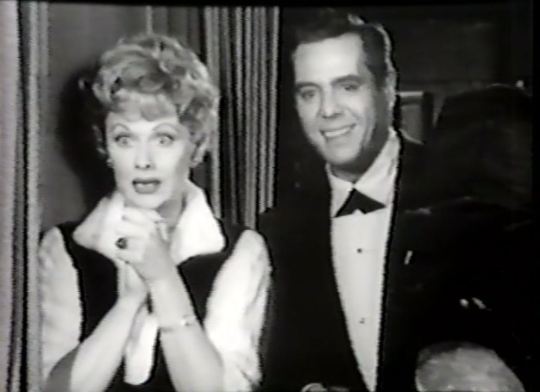
Desi Arnaz was born in Cuba in 1917 and immigrated to America as a youngster. He was a musician who married Lucille Ball in 1940 after meeting her on the set of 1939’s Too Many Girls, which he had done on stage in New York. In order to keep him ‘off the road’ Ball convinced producers to cast him as her husband in a new television project based on her radio show “My Favorite Husband.” The network was convinced. In 1951, Arnaz and Ball began playing Lucy and Ricky Ricardo, roles they would be identified with for the rest of their lives. The couple had two children together, Lucie and Desi Jr. In 1960, Ball and Arnaz divorced. Desi became a producer, responsible for such hits as “The Mothers-in-Law” (1967-69). He re-married in 1963. Desi Aranz died in 1986, just a few years before Ball.
Desi also narrates the program.
Special Guest Star
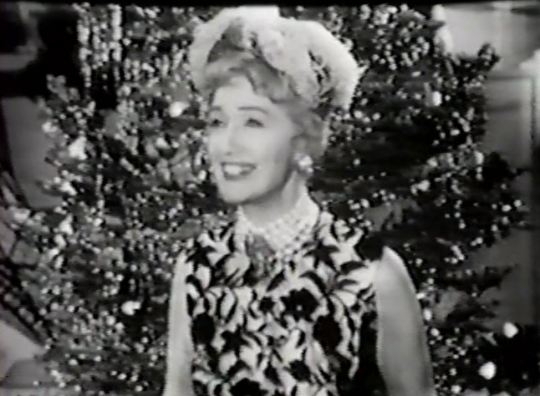
Hedda Hopper was born Elda Furry in Hollidaysburg, Pennsylvania. She was one of Hollywood’s most powerful and influential columnists. She appeared on “I Love Lucy” and “The Lucy-Desi Comedy Hour.” Among her hundreds of films as an actress, she did two with Lucille Ball: Bunker Bean (1936) and That’s Right – You’re Wrong (1939). Hopper was best known for her flamboyant hats. In films and television, Hopper has been portrayed by such actors as Fiona Shaw (RKO 281), Jane Alexander (Malice in Wonderland), Katherine Helmond (Liz: The Elizabeth Taylor Story), Helen Mirren (Trumbo), Tilda Swinton (Hail, Caesar!), Judy Davis (“Feud”), and Holly Kaplan (”Hollywood”).
With...
William Frawley was already a Hollywood veteran when he was hired by Desi Arnaz to play Fred Mertz on “I Love Lucy.” After the series concluded he joined the cast of “My Three Sons” playing Bub Casey. His final appearance before his death in March 1966 was as a stable groom on an episode of “The Lucy Show,” also featuring Ann Sothern.
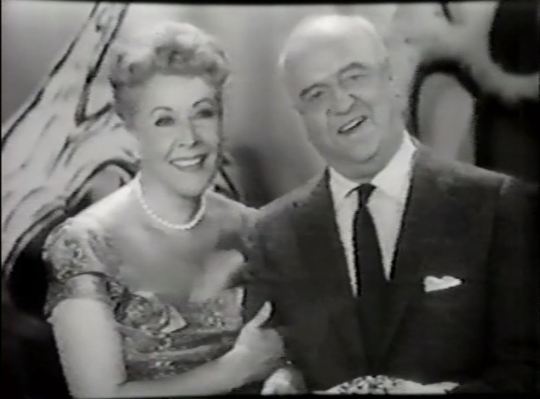
Vivian Vance was born Vivian Roberta Jones in Cherryvale, Kansas in 1909, although her family quickly moved to Albuquerque, New Mexico where she was raised. She had extensive theatre experience, co-starring on Broadway with Ethel Merman in “Anything Goes.” She was acting in a play in Southern California when she was spotted by Desi Arnaz and hired to play Ethel Mertz, Lucy Ricardo’s neighbor and best friend. The pairing is credited with much of the success of “I Love Lucy.” Vance was convinced to join the cast of “The Lucy Show” in 1962, but stayed with the series only through season three, making occasional guest appearances afterwards. She made a total of six appearance on “Here’s Lucy.” She also joined Lucy for a TV special “Lucy Calls the President” in 1977. Vance died two years later.
Guests...
John Bromfield (Audience Member) was best known for playing the title role in the Desilu / CBS series “U.S. Marshal.” He retired from acting in 1960 to become a commercial fisherman. In 1959, he was married to Larri Thomas, who appeared in “Lucy Wants a Career” (1959) on “The Westinghouse Desilu Playhouse.” He died in 2005 at age 83.
Spring Byington (below) received an Academy Award nomination for her role as Penelope Sycamore in You Can't Take It with You (1938). She appeared in twenty Broadway plays between 1924 and 1935. She made her film debut as Marmee March in 1933's Little Women. Her career included a seven-year run on radio and television as the star of “December Bride,” a Desilu / CBS production. The show followed “I Love Lucy” on the CBS Monday night line-up from Fall 1954 to Spring 1959. Desi Arnaz played himself on a 1956 episode of the series. She was a former MGM contract player who appeared in films from the 1930s to the 1960s. She played the “Batman” character J. Pauline Spaghetti in 1966. Byington made an appearance on the Desilu series “The Greatest Show on Earth” in 1964. Her final roles were as Major Nelson's mother on “I Dream of Jeannie” in 1967 and as the Mother General on “The Flying Nun” in 1968. She died in 1971 at age 84.
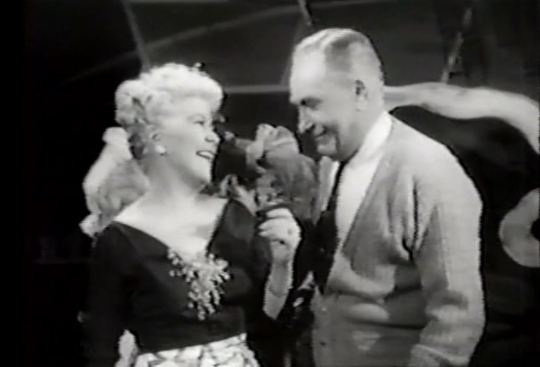
William Demarest (above) was best remembered as Uncle Charlie on “My Three Sons,” a role created after the death of William Frawley. This is one of two times Demarest and Frawley appeared together on screen. The other was in The Farmer's Daughter (1940). He was nominated for an Academy Award in the biography, The Jolson Story (1946). Demarest did three films with Lucille Ball, including Sorrowful Jones (1949). He died in 1983 at age 91.
Lita Baron (Audience Member, below) was born Isabelita Castro and played Ricky Ricardo's former dance partner Renita Perez in “Cuban Pals” (ILL S1;E28). She also appeared in the films Club Havana (1945) and Don Ricardo Returns (1946). Despite this, Baron was actually born in Spain, not Cuba. From 1948 to 1970 she was married to actor Rory Calhoun and had appeared on his CBS / Desilu series “The Texan.”
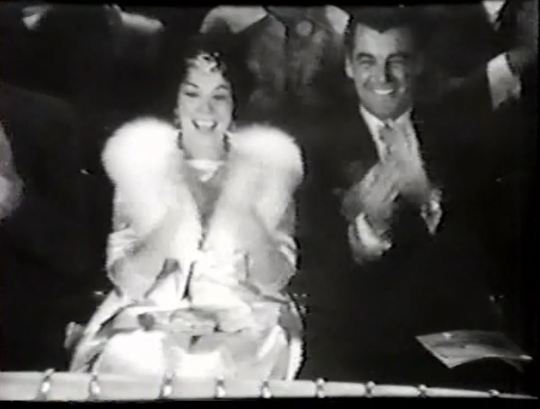
Rory Calhoun (Audience Member, above) starred in many Westerns in the 1950s and '60s and was famous for his black cowboy hat. As a young man he spent some time in prison. Born Francis Timothy McCown, his screen name was given to him by David O. Selznick. In 1959 he was appearing in the CBS / Desilu show “The Texan” (1958-60).
Bonita Granville (Audience Member) was nominated for an Oscar in 1937 for These Three. She was also known as Nancy Drew from the serials of the 1930s. In 1959, Granville became producer of the TV series “Lassie” and this is probably the reason she is in the audience here.
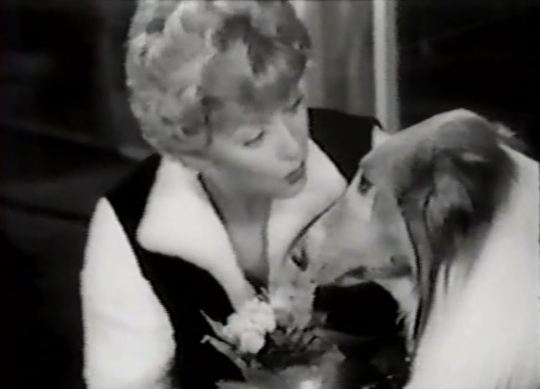
Lassie is one of the most famous canine stars in Hollywood history. From 1954 to 1974, Lassie had her own series. The collie also starred in numerous films. She was mentioned on “I Love Lucy.”
George Murphy (Audience Member) started singing and dancing on Broadway at age 25. There he is credited with introducing Bob Hope to his wife Dolores. In Hollywood, he became Screen Actors Guild (SAG) President and was eventually elected US Senator. He was given a special Oscar in 1950. Murphy was in four films with Lucille Ball between 1934 and 1941. He starred with Desi Arnaz in The Navy Comes Through (1942) and Bataan (1943). In 1959, Murphy and Desi switched roles when Desi took a role in his own anthology series “The Westinghouse-Desilu Playhouse” and Murphy acted as guest host. Murphy interviewed Lucy and Desi for “MGM Parade” in February 1956. He died in 1992 at age 89.

Ann Sothern appeared in the first “Lucy-Desi Comedy Hour” “Lucy Takes a Cruise to Havana” (1957) as Susie MacNamara, the same character she played on her show “Private Secretary” from 1953 to 1957. In return Lucille Ball played Lucy Ricardo on her show in 1959. Sothern appeared with Ball in five films between 1933 and 1943. On “The Lucy Show” Sothern made three appearances as Rosie, the Countess Framboise. She was nominated for an Oscar for her final screen appearance in The Whales of August in 1987. She is buried near her home in Sun Valley, Idaho, a place also dear to Lucy and Desi.
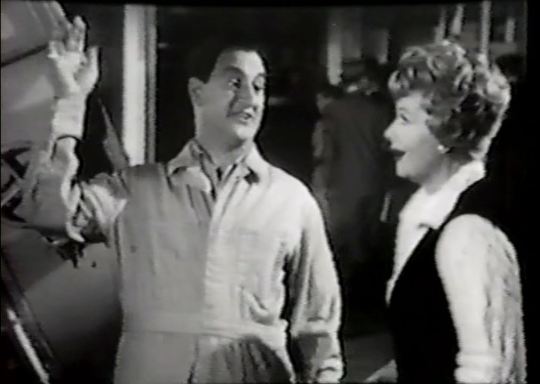
Danny Thomas was born Amos Muzyad Yakhoob Kairouz in 1912. His screen career began in 1947 but he was most famous for appearing on television in the long-running show “Make Room for Daddy” (1953-64), which was shot at Desilu Studios. When the series moved from ABC to CBS in 1957, Thomas and the cast starred in a rare TV cross-over with “The Lucy-Desi Comedy Hour” titled “Lucy Makes Room for Danny” (December 1958). In return, Lucy and Desi turned up on Thomas’s show. Fifteen years later, Lucy and Danny did yet another cross-over when Lucy Carter of “Here’s Lucy” appeared on “Make Room for Granddaddy.” In addition, Thomas also played an aging artist on a 1973 episode of “Here’s Lucy.” He died in 1999.
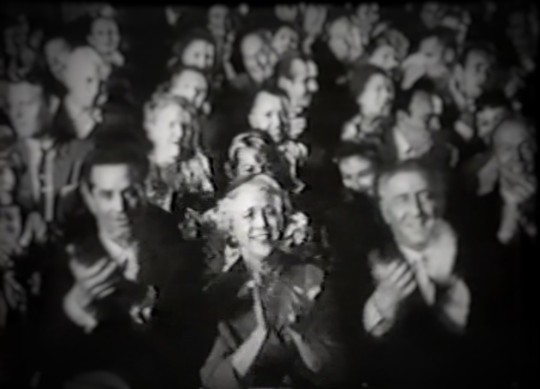
Bess Flowers (Audience Member, uncredited) was dubbed ‘Queen of the Extras’ in Hollywood and is credited with more than 700 film and TV appearances from 1923 to 1964. She was seen in the audience of Over the Teacups in “Ethel’s Birthday” (ILL S4;E8) and The Most Happy Fella during “Lucy’s Night in Town” (ILL S6;E22). Flowers also made five uncredited appearances on “The Lucy Show.” Not surprisingly, she was a founding member of SEG, the Screen Extras Guild (now part of SAG) in 1945. She appeared in more films with Lucille Ball than any other performer.
Cast of the Desilu Workshop...

Robert Osborne was the host on Turner Classic Movies from its inception in 1994, in large part due to his knowledge of film. It was Lucille Ball who suggested that Osborne combine his interest in classic film and training in journalism, and write instead of act. Osborne took this advice and produced "Academy Awards Illustrated" a book which then begat his years at The Hollywood Reporter. He also became the official historian of the Academy of Motion Picture Arts and Sciences. He also acted in “Chain of Command” for the “Westinghouse Desilu Playhouse,” also in 1959, and also with Hugh O'Brien. Osborne died in 2017 at age 84.
Billed as “Bob Osborne” in the opening number.
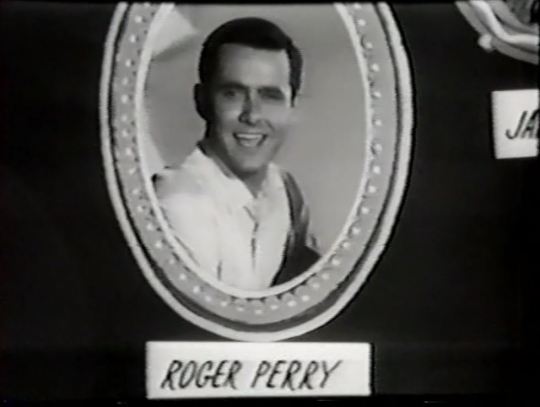
Roger Perry also appeared in “Ballad of a Bad Man” for “Westinghouse Desilu Playhouse” in 1959 written by Desi Arnaz. He later starred in Desilu's “Mannix” and “Star Trek.” He died in July 2018 at age 85.
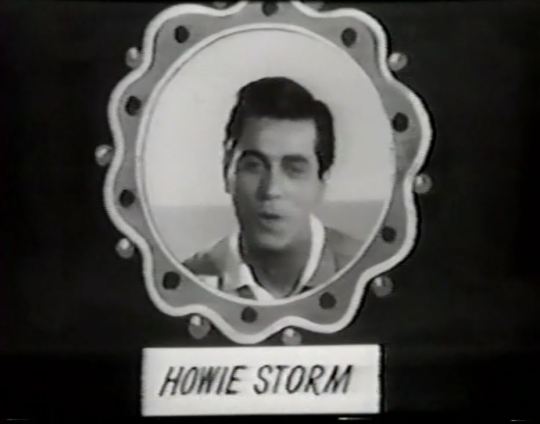
Howard Storm married fellow Playhouse cast member Marilyn Lovell in 1959. He started directing in 1975. In 1959 he appeared in the CBS series “Hennessy” and the following year made an appearance on the Desilu series “The Untouchables.”
Billed as “Howie Storm” in the opening number.
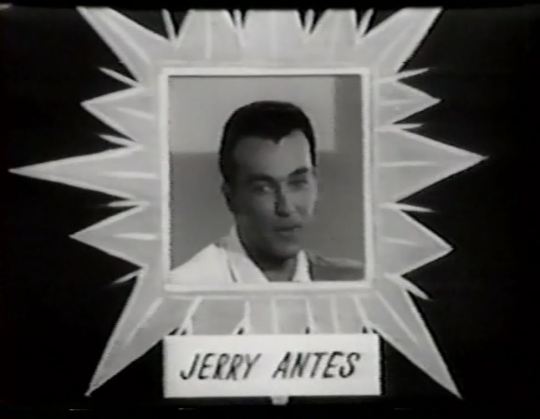
Jerry Antes graduated from Hollywood Professional School in 1944. In “Hedda Hopper's Hollywood” Lucille Ball calls him by name in their brief promotion of the Desilu Playhouse. Prior to this, Antes was a dancer who made three appearances on “The Alan Young Show” (1950).
Majel Barrett was later cast as Nurse Chapel on Desilu’s new space adventure series, “Star Trek.” During this time she had a relationship with the show’s creator Gene Roddenberry, marrying him in 1969, the same year the series was canceled. She was part of most all iterations of “Star Trek” until her death in 2008. In 1962 she played a secretary in “Lucy is Kangaroo for a Day” (TLS S1;E7).
Billed as “Majel Barret” in the opening number.
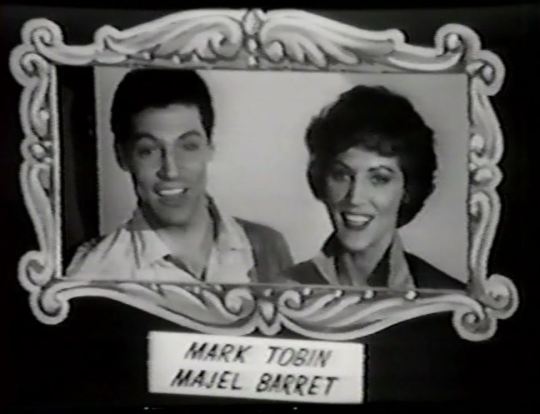
Mark Tobin appeared on the TV series “Lock-Up” in 1959. He made two appearances on the original “Star Trek,” one as a Klignon. He also played a Klignon on “Star Trek: Voyager” in 1999.
Robert Barron made the 'B' movie Tank Commandos in 1959. He only has one other credit of record, a 1964 appearance in the film The Ballad of a Gunfighter. He died in 2002 at age 78. This may be due to the misspelling of his surname.
Billed as “Rob Barran” in the opening number.
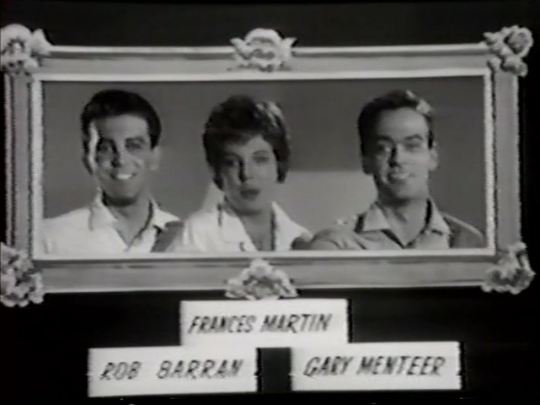
Fran Martin
Billed as “Frances Martin” in the opening number.
Gary Menteer started his career as a dancer, but later transitioned to being a writer, director, and casting agent, earning two Emmy nods for “Punky Brewster” (1984-88). He died in 2016 at age 76.
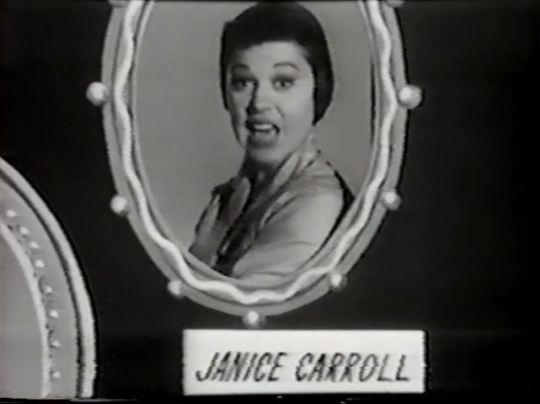
Janice Carroll started playing background characters and uncredited roles in 1951. In 1959 she appeared in the Desilu series “U.S. Marshal.” Her final screen appearance was in 1987. She died in 1993 at age 61.
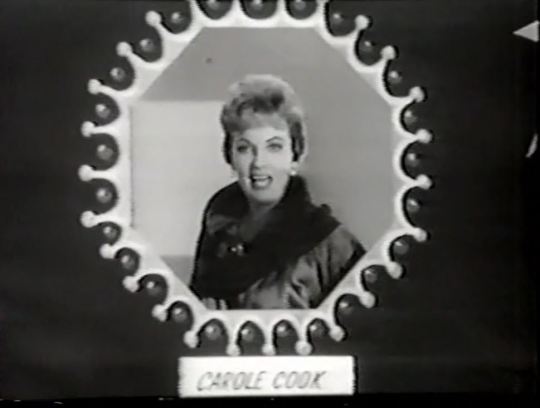
Carole Cook made four appearances playing Thelma Green on “The Lucy Show,” although she also played Mrs. Valance in three episodes and a variety of other characters in eleven others. Although she was born as Mildred Cook, Ball suggested she take the name Carole, in honor of Lucy’s great friend, Carole Lombard. Cook also went on to appear in five episodes of “Here’s Lucy.”
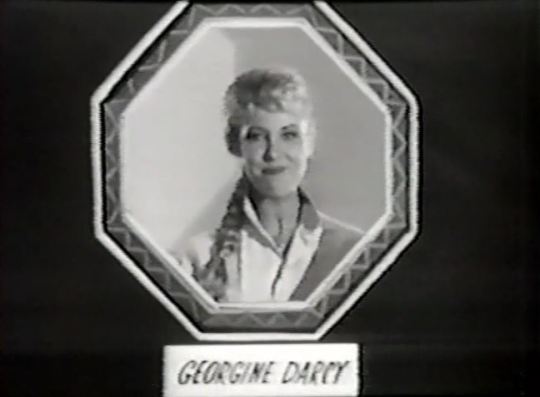
Georgine Darcy was most famous as Miss Torso in the Hitchcock thriller Rear Window (1954), her screen debut. In 1958 she made a single appearance on “Make Room for Daddy” filmed by Desilu. Her final appearance was on Desilu's “Mannix” in 1971. As part of the Desilu Playhouse, she was also seen in “Hedda Hopper's Hollywood.” She died in 2004 at age 73.
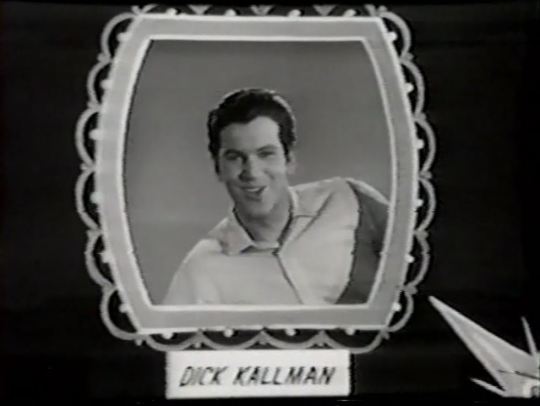
Dick Kallman was next cast as a bellboy in the final “Lucy-Desi Comedy Hour” “Lucy Meets the Mustache” (1960). Kallman replaced Tommy Steele on Broadway in the musical Half a Sixpence. The actor was killed during a robbery in 1980.
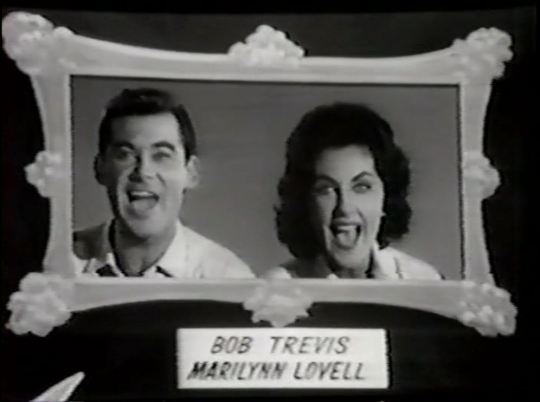
Bob Travis had only one previous screen credit, appearing on “The Jack Paar Tonight Show” in September 1958.
Billed as “Bob Trevis” in the opening number.
Marilyn Lovell was a singer who appeared in Hollywood and New York. Her first husband was Desilu Playhouse member Howie Storm. Her second husband was Carol Burnett's musical director Peter Matz. In 1959 she made an appearance on CBS's “Tightrope.” She died in 2012 at age 80.
Billed as “Marilynn Lovell” in the opening number.

John O'Neill was primarily a singer, who sang the title tune of the Western series “Wagon Train” (1958-59). He appeared in Young Jesse James (1960), and is rumored to have been one of the whistlers for the theme of The Good, The Bad, And the Ugly (1966).
Billed as “Johnny O’Neill” in the opening number.
About “The Westinghouse Desilu Playhouse”
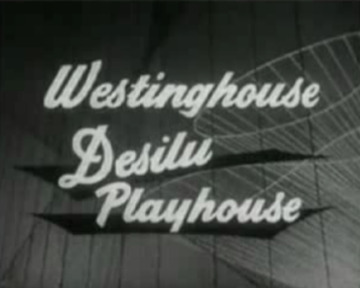
After the end of the half-hour “I Love Lucy” episodes, Desi Arnaz convinced CBS to purchase an anthology series titled “Desilu Playhouse” which would feature different hour-long dramas every week along with monthly stories of the Ricardos and the Mertzes.
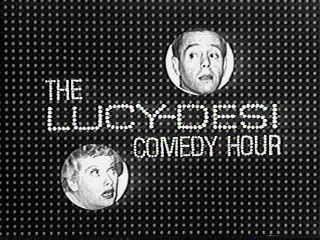
Thirteen hour-long “I Love Lucy” adventures were eventually made and sold to syndication as “The Lucy-Desi Comedy Hour,” ten of which were produced under Westinghouse sponsorship. The appliance company paid a then-record 12 million dollars to sponsor the show, which resulted in the cancellation of their prestigious “Studio One” anthology show. Desi Arnaz hosted the show and introduced the stories from in front of a show curtain (ostensibly at the Desilu Playhouse).
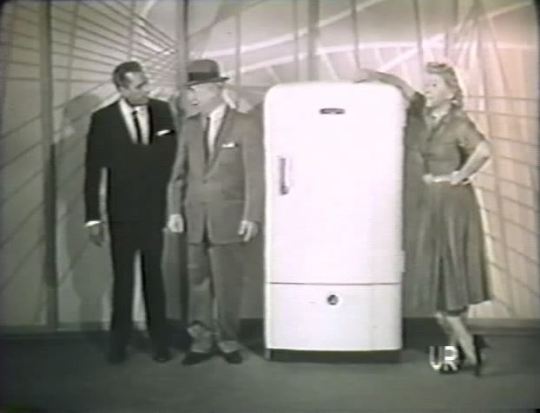
Desi, Lucy, Vivian Vance, and William Frawley, were often involved in the lengthy studio-filmed Westinghouse commercials and promotions, with Betty Furness spokesperson for the Westinghouse products.
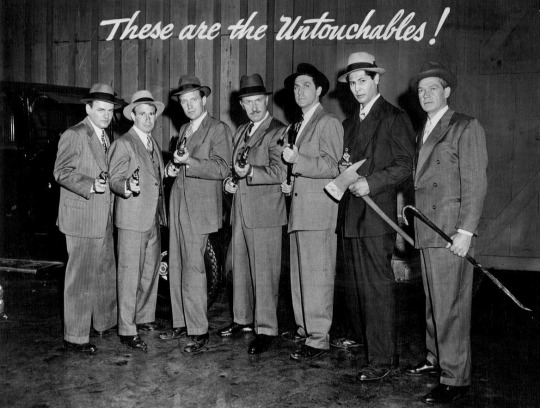
Although it wasn't around long, the series gave birth to pilots for “The Untouchables” and “The Twilight Zone.” In fact, many entries proved to be pilots for series, not all of which were produced.
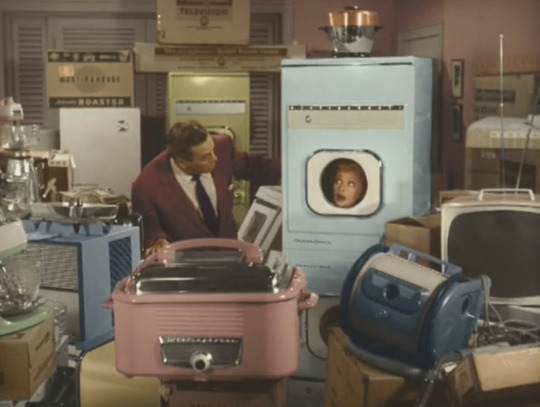
In the summer of 1958, in anticipation of the partnership, the cast of “I Love Lucy” played themselves in aun industrial film that toured the Desilu Studios, promoted “Lucy Goes to Mexico” and highlighted Westinghouse appliances. The film was never broadcast, but only made to show Westinghouse dealers and corporate clients. Years later it was colorized for video.
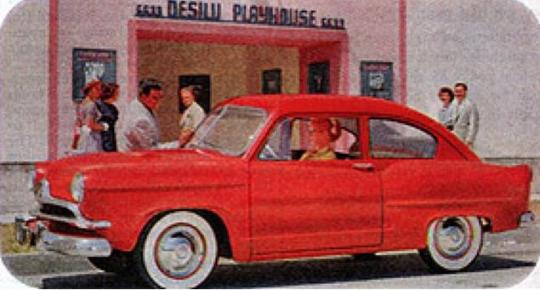
The Desilu Playhouse was an actual little theatre on the Desilu backlot which hosted classes for actors and put shows for agents and industry insiders.
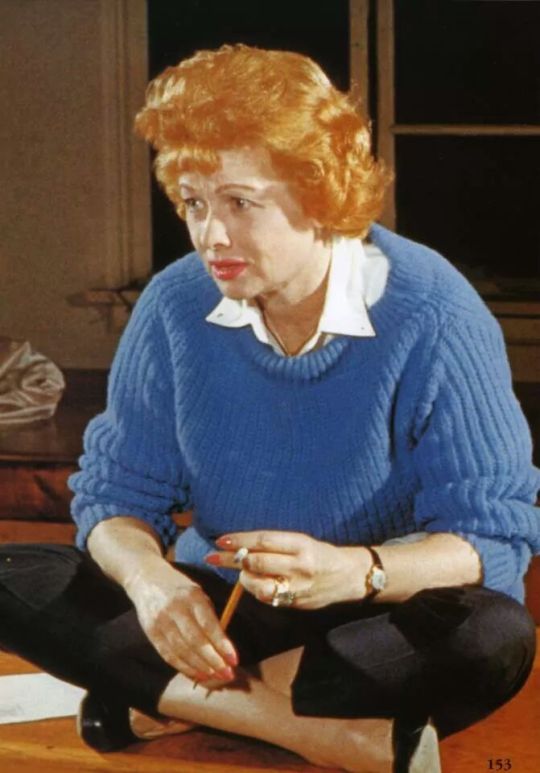
When Lucille Ball joined RKO in the 1930s, the program was headed by Ginger Rogers' mother, Lela. Lucille wanted to continue the tradition.
About “The Desilu Revue”
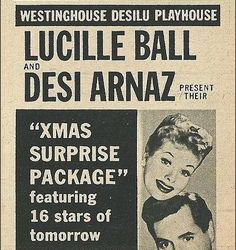
In late 1959, sixteen of the workshop actors joined the “I Love Lucy” cast in creating a holiday special. The show aired on Christmas Day 1959 and featured gossip columnist Hedda Hopper as well as many other stars then working on the Desilu lot.
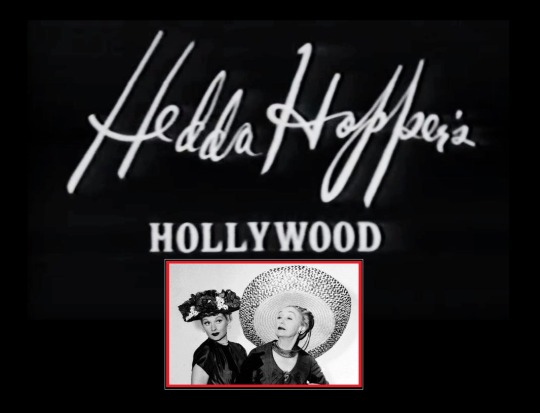
Hopper also took the opportunity to shoot footage for her own TV special, “Hedda Hopper's Hollywood”, with Lucy cross-promoting her special.
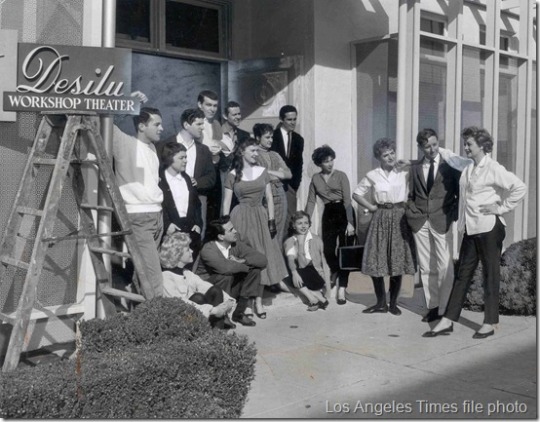
This is essentially a musical variety show starring the members of the Desilu workshop, actors Desilu was grooming to appear in series’ or launch their careers in films. Among the most famous to participate were Robert Osborne (future host of Turner Classic Movies) and Carole Cook, who went on to play character roles on Lucy's sitcoms and on Broadway. Majel Barrett would become known as “the mother of Star Trek” (a Desilu series) and wife to Gene Rodenberry, the show's creator.
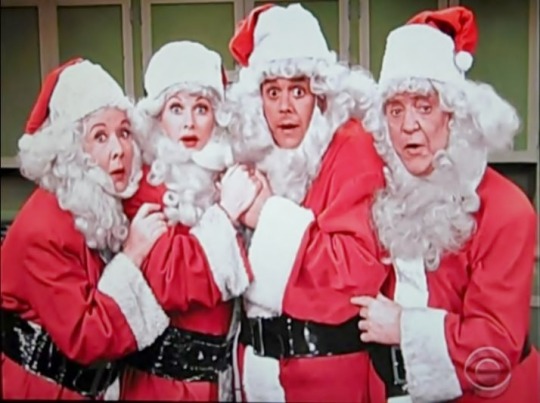
This program was aired only once. It is one of just a handful of holiday programs produced by Lucille Ball. A Christmas 'tag' was added to episodes of “I Love Lucy” until it was fleshed out into a full-length flashback show during season six. “The Lucy Show” produced two Christmas themed episodes, and one for New Year's Eve.
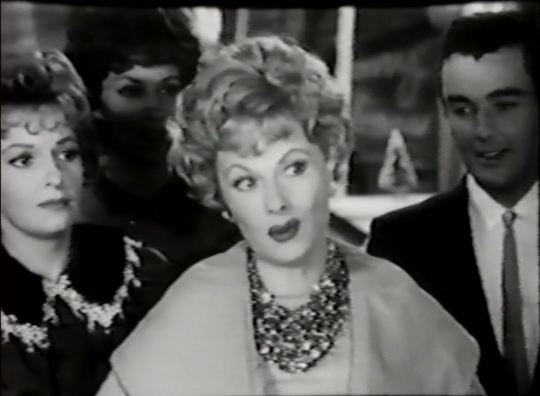
The show opens with Lucille Ball driving a golf cart through the studio streets laden down with a stack of Christmas presents and a decorated Christmas tree. Desi Arnaz narrates. Inside the Desilu Playhouse, the cast are decorating the theatre and singing “Jingle Bells.” Hedda Hopper arrives and compliments the tree:
Hedda Hopper: “It would make a stunning hat!”
Hopper is going to do a column on the 'kids' of the workshop. As Lucy dashes off to check on the catering from the commissary, Desi tells Hedda how nervous Lucy was during the opening night of their first workshop production. Flashback to opening night – and Lucy is backstage busily checking in with all of the ‘kids’ in the workshop.
Lucy has prevailed upon nearly everyone at Desilu to pitch in. William Demarest and Spring Byington are working on costumes. Lassie delivers opening night flowers to Lucy. Vivian Vance is doing make-up. William Frawley is the stage doorman.
Lucy reprimands Janice Carroll for peeking through a hole in the curtain to see her mother – it is bad luck. Lucy asks Desi to conduct the orchestra instead of their usual conductor. Ann Sothern (wearing a tiara and fur stole) takes tickets – in between signing her autograph for fans.
Danny Thomas is outside operating the huge searchlight. He tells Lucy that he started in show business as an usher in the movies with a tiny flashlight – and look at him now!
Desi enters the auditorium with his baton to start the show, but cannot find the entrance to the orchestra pit. After a few words with audience member George Murphy, he jumps the railing.
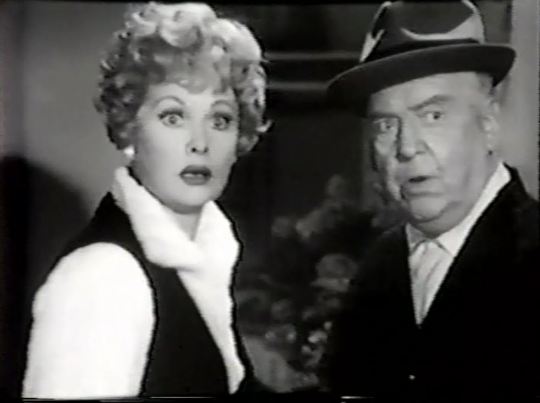
Lucy barrels through the stage door to deliver her last minute notes to the cast but is stopped by Bill Frawley, remembering Desi's orders to keep Lucy away from the cast. His behavior surprises Lucy.
Lucy: “Bill Frawley how can you be so mean?” Frawley: “Don't think of me as Bill Frawley. Think of me as Fred Mertz.” [evil laugh]
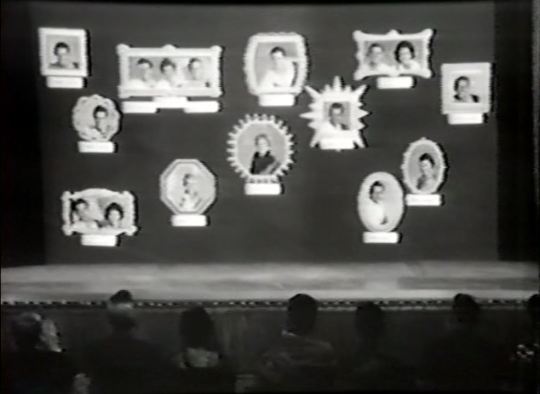
The 16 workshop members sing the opening number “We Wanna Be By You” written for the show by Walter Kent and Walton Farrar.
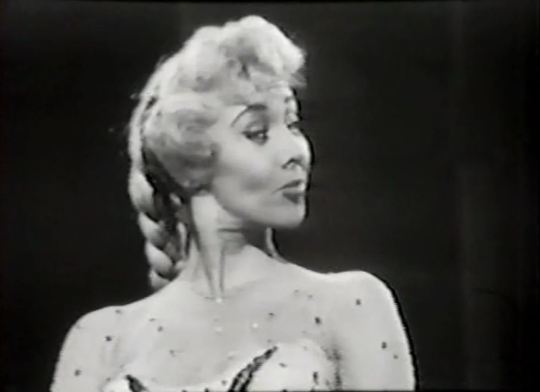
Next up is a jazz dance routine featuring Georgine Darcy, Jerry Antes, and Gary Menteer.
Vivian discovers Lucy trying to sneak backstage through a dressing room window. Lucy threatens to tell the audience Vivian's real age if she doesn't let her in! Bill Frawley discovers Lucy giving notes to the cast. His scowl scares Lucy into leaving the same way she came in!
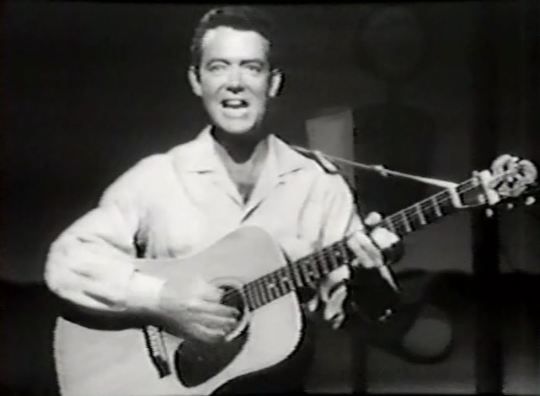
Johnny O'Neill sings “Fast Freight” by Terry Gilkyson while accompanying himself on the guitar. The song was a 1958 hit for The Kingston Trio.
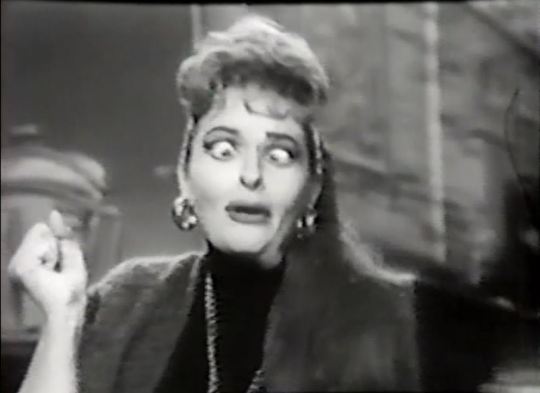
Dick Kallman (sporting a goatee) and Carole Cook do a beatnik number called “Hip To The Blues” by Baker, Young, Raskin, and Burger.
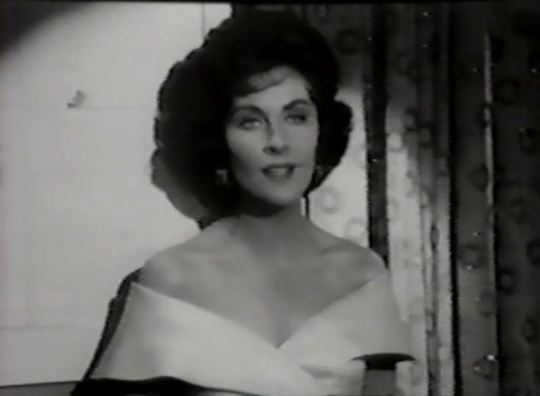
Marilyn Lovell sings the torch song “I Still Remember.”
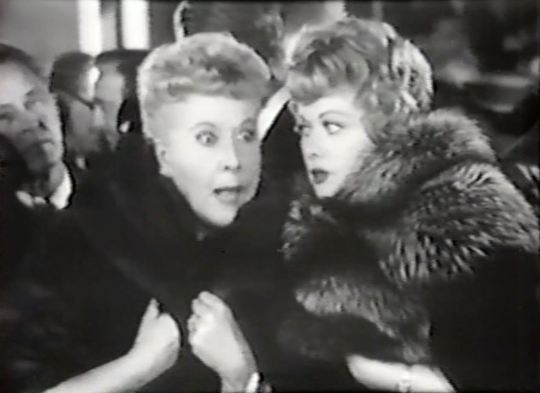
During the intermission, Lucy and Vivian bury themselves in fur coats up to their eyeballs to listen to the producers’ chatter about the first act. The only thing they overhear is that Ann Sothern has lost her gloves!
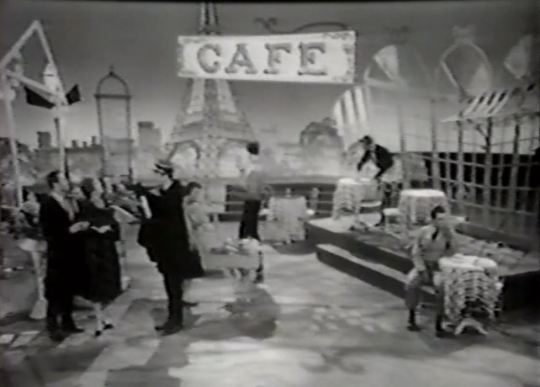
Act Two opens on a busy Parisian street with an American sailor on leave. The sailor sings “I'm in Love With Paris.” An Army officer sitting at a café table sings “Alone In Gay Paris.”
In the dressing room, Bob Osborne reads a note from Lucy written on the mirror in lipstick. It references using a hand mike in “the bandstand number.” Curiously, no such song is in the show. Perhaps it was cut or (more likely) never existed.

Carole Cook sings a comedy song called “Whistler's Mother” by Mike Stewart and Shelley Mowell. In it, Cook is seen as a tableau vivant of the famous painting come to life. She steps out of the frame and transforms into a vamp.
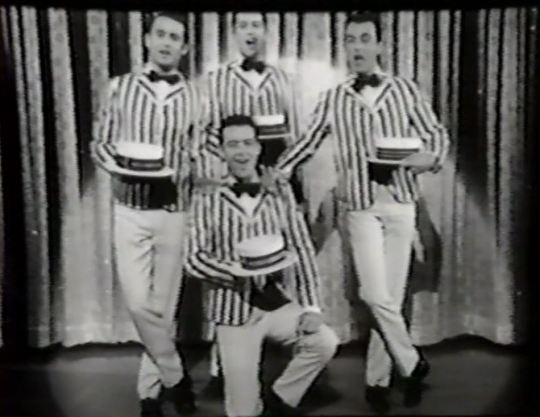
A barbershop-style song “Summertime is Summertime” by Walter Kent and Kim Gannon is sung by four of the men in candy striped suits and straw boaters. It opens up into a gay nineties dance number. It finishes with a cake walk to “Hey Do Ya Love Me Honey” led by Roger Perry singing and playing the piano.
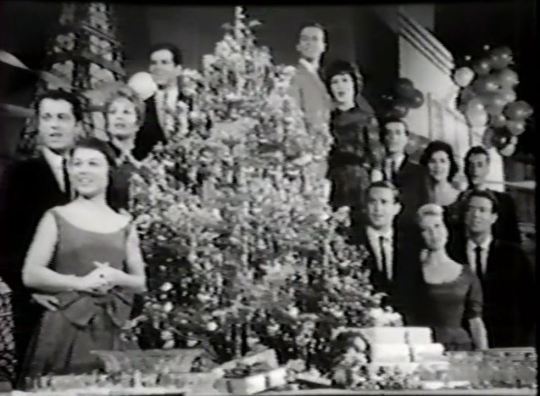
The program returns to the present and the Desilu Playhouse Christmas Party with Desi telling Hedda Hopper what happened on opening night. The workshop members sing “Let's Pretend It's Christmas Eve” while Lucy, Desi, Bill, Vivian, and Hedda look on adoringly.

Overcome with emotion, Vivian Vance impulsively gives Bill Frawley an affectionate kiss on the cheek and whispers “Merry Christmas” to him. Surprisingly, he returns the favor. Considering the well-known friction between the two, this is either very convincing acting or the pair had mended fences knowing their decade working together was finally drawing to an end. Vance had just nixed an “I Love Lucy” sequel about the Mertzes, despite the fact that Frawley was open to the idea.

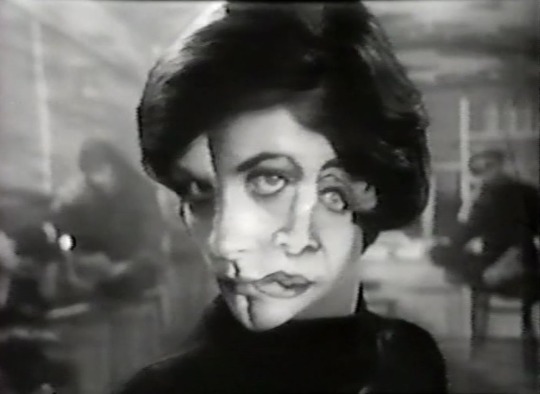
Not a camera trick! Make-up by Fred Phillips!
#The Desilu Revue#Westinghouse Desilu Playhouse#Westinghouse#Desilu#Lucille Ball#Desi Arnaz#Hedda Hopper#Vivian Vance#willliam frawley#Christmas#Revue#1959#Robert Osborne#Carole Cook#Majel Barrett#The Desilu Playhouse#RKO#Claudio Guzman#Bert Granet#Bob Schiller#Bob Weiskopf#The Lucy-Desi Comedy Hour#Hedda Hopper's Hollywood#Walter Kent#Walton Farrar#John Bromfield#Spring Byington#William Demarest#Lita Baron#Rory Calhoun
4 notes
·
View notes